The Big List of 125+ Metaphor Examples and Tips for Writers
Metaphors are everywhere! To help you understand this rhetorical device, here’s a big list of 125+ metaphor examples (plus tips for writers ). But first, let’s talk about the engine of storytelling that make metaphors work.

All About Metaphors
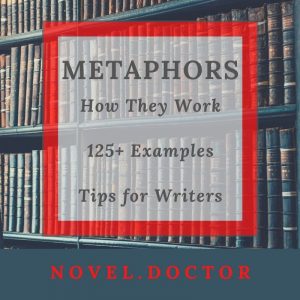
What is a metaphor?
A metaphor compares two dissimilar things by equating one thing as the other thing. By this comparison, our minds can bring one idea into the conceptual space of another idea. When you compare two objects, one of them is seen in a different light, illuminated and re-configured through that comparison.
The concrete becomes abstract, the ephemeral grounded momentarily, the unknown related to the known in a way that helps us understand. This tendency to compare two unlike things is a very human activity.
In fact, our brains are designed to think in metaphorical constructs. George Lakoff explains that “One of the fundamental findings of cognitive science is that people think in terms of frames and metaphors […] The frames are in the synapses of our brains, physically present in the form of neural circuitry. When the facts don’t fit the frames, the frames are kept and the facts ignored.” We see things differently when we look through the lens of metaphor.
Our minds weave ideas together continuously so that we can better understand events, objects, and even people and their motivations. Metaphors are not literal at all — in fact, they are intentionally told as figurative retellings of the world, laying a fabric of imaginative story over raw reality and transforming that reality into a mini-story.
Before we get to the big list of metaphor examples , it’s useful to know there are different ways of writing metaphors.
Metaphor VS. Simile
Metaphor is the big idea behind the comparison between two different objects. However, in English, we use two different words to describe different instances of the rhetorical device known as a metaphor.
A metaphor proper compares two things by simply stating that this thing is that thing. A = B.
Metaphor Examples
Examples of basic metaphors include:
- “Mary is a ray of sunshine.”
- “I’m swimming in emails.”
- “Vacation is heaven.”
- “Love is a battlefield.”
Simile Examples
A simile is a metaphor that uses the words like or as to make the same sort of metaphorical comparison.
Examples of similes in action include:
- “Dale works like a grumpy donkey.”
- “Life is like a box of chocolates.”
- “Her face shines as a jewel.”
Writers on Metaphorical Writing
Metaphors can bring the joy of storytelling into every sentence that you create and can propel your readers forward through your story. To provide you with a navigational map through the sea of metaphors, I’ve listed 125 metaphor examples at work. But before we get to the big list, let’s see what famous writers have said about the power of metaphor.
The British novelist Mary Anne Evans (who published as George Eliot ) wrote about how metaphor compels us to act: “For we all of us, grave or light, get our thoughts entangled in metaphors, and act fatally on the strength of them.”
The Czech writer Milan Kundera agreed with Eliot. He wrote: “Metaphors are dangerous. Metaphors are not to be trifled with.” Yet despite this danger, novelists need to use metaphor to communicate deeper truths.
The hilarious Terry Pratchett sums up the idea in one of his novels: “A metaphor is a kind o’ lie to help people understand what’s true.”
Pratchett was on the right path. Because as one of the authors of the entire modern way of thinking about logic and storytelling told us, achieving master in metaphor is the height of storytelling. Aristotle said: “The greatest thing by far is to be a master of metaphor; it is the one thing that cannot be learnt from others; and it is also a sign of genius, since a good metaphor implies an intuitive perception of the similarity in the dissimilar.”
The inimitable Ray Bradbury described his writing this way: “I speak in tongues. I write metaphors. Every one of my stories is a metaphor you can remember. The great religions are all metaphor. We appreciate things like Daniel and the lion’s den, and the Tower of Babel. People remember these metaphors because they are so vivid.”
Finally, the Italian novelist and critic Umberto Eco explained the device precisely: “Metaphors set up not only similarities but also oppositions. A cup and a shield are alike in their form (round and concave), but opposite in their function (peace vs. war), just as Ares and Dionysus are alike insofar as they are gods, but opposite with regard to the ends they pursue and to the instruments they use.”
The Big List of 125+ Metaphors
Metaphors make us human and bring us into a story. They serve as guideposts on the storytelling path and help us navigate our experience. The wonderful novelist Haruki Murakami tells us that we should not try to explain them, but instead embrace the idea. Murakami writes: “Allegories and metaphors are not something you should explain in words. You just grasp them and accept them.”
In the big list of metaphor examples below, you’ll find metaphors from many writers in many genres of literature.
Browse freely — skip around! Enjoy swimming in the sea of metaphor!
Everyday Expressions
Human beings naturally think in metaphor. So you probably use metaphorical ideas in conversation every day. Metaphorical expressions populate the English language with verve and insight. Here are a few everyday expressions that are, in fact, metaphors.
Fit as a fiddle
Happy as a clam
Dull as dishwater
That man is a pig.
She is an old flame
Silent as the grave
Time is money
He is sharp as a tack
You are my sunshine
You are the light in my life.
That politician is a lame duck.
Don’t talk to a brick wall
She has ants in her pants.
Fear feeds on attention.
Depression is a dark shadow.
Joy is a gift.
Life is a journey.
She’s a late bloomer.
Human beings invented storytelling when our communication was an oral culture. Stories we told around the fire, or sung by storytellers who memorized by listening to other storytellers. In fact, early writers such as Socrates and Plato argued about the relative merits of writing stories down instead of telling or singing them! Today, storytellers continue to use song to entrance us — and every lyricist uses metaphors.
It might seem crazy what I’m ’bout to say / Sunshine she’s here, you can take a break / I’m a hot air balloon that could go to space / With the air, like I don’t care, baby, by the way– Pharrell Williams – Happy
I can’t let you go, your hand prints on my soul / It’s like your eyes are liquor, it’s like your body is gold– End Game, Taylor Swift
See the girl with the diamonds in her shoes? Yeah / She walks around like she’s got nothing to lose / Faith– Stevie Wonder and Ariana Grand
Did I ever tell you you’re my hero? / You’re everything, everything I wish I could be / Oh, and I, I could fly higher than an eagle / For you are the wind beneath my wings / ‘Cause you are the wind beneath my wings “Wind Beneath My Wings,” Bette Midler
If this town / Is just an apple / Then let me take a bite– “Human Nature,” Michael Jackson
You are my fire / The one desire / Believe when I say I want it that way– “I Want It That Way,” Backstreet Boys
Your body is a wonderland / Your body is a wonder (I’ll use my hands) / Your body is a wonderland– “Your Body Is A Wonderland,” John Mayer
The world was on fire and no one could save me but you / It’s strange what desire will make foolish people do…. / What a wicked game you play, to make me feel this way — Wicked Game, Chris Isaak
I’m walking on sunshine (Wow!) / I’m walking on sunshine (Wow!) / I’m walking on sunshine (Wow!) / And don’t it feel good —“I’m Walking On Sunshine,” Katrina and the Waves
If you wanna be with me / Baby there’s a price to pay / I’m a genie in a bottle / You gotta rub me the right way– “Genie in a Bottle,” Christina Aguilera
If God is a DJ, life is a dance floor / Love is the rhythm, you are the music / If God is a DJ, life is a dance floor / You get what you’re given it’s all how you use it– “God Is A DJ,” P!nk
My heart’s a stereo / It beats for you, so listen close / Hear my thoughts in every note– “Stereo Hearts,” Gym Class Heroes
I’m the sunshine in your hair / I’m the shadow on the ground / I’m the whisper in the wind / I’m your imaginary friend– “I’m Already There,” Lonestar
A tornado flew around my room before you came / excuse the mess it made, it usually doesn’t rain in Southern California– Thinking Bout You – Frank Ocean
Oh, she got both feet on the ground / And she’s burning it down / Oh, she got her head in the clouds / And she’s not backing down / This girl is on fire– Alicia Keys – Girl On Fire
Metaphor is used extensively in the literary arts. In fact, much of the formalist movement in literary criticism focused on analyzing the effects and the implications of metaphor in literature.
Writers therefore often think in metaphors. This is the common mode of expression of great writers. Here are examples from several of our greatest literary thinkers.
In the depths of winter, I finally learned that within me there lay an invincible summer. —Albert Camus
Books are mirrors of the soul. — Virginia Woolf
She is a friend of my mind. She gather me, man. The pieces I am, she gather them and give them back to me in all the right order.― Toni Morrison
“Anger is the wind which blows out the lamp of the mind.” ― Bodie Thoene
“If funkytown was a trailerpark, this guy would be a double-wide.”― Maya Angelou
What therefore is truth? A mobile army of metaphors, metonymies, anthropomorphisms: in short a sum of human relations which become poetically and rhetorically intensified, metamorphosed, adorned, and after long usage seem to a nation fixed, canonic and binding. —Friedrich Nietzsche
Dying is a wild night and a new road. —Emily Dickinson
I have a huge and savage conscience that won’t let me get away with things.― Octavia E. Butler
And your very flesh shall be a great poem.– Walt Whitman
“Happiness is the china shop; love is the bull.” ― H.L. Mencken
“Life is a moderately good play with a badly written third act.” ― Truman Capote
“Religion is the sigh of the oppressed creature, the heart of a heartless world, and the soul of soulless conditions. It is the opium of the people…. Religion is only the illusory Sun which revolves around man as long as he does not revolve around himself.” ― Karl Marx
“Failure is the condiment that gives success its flavor.” ― Truman Capote
“I’m a little pencil in the hand of a writing God, who is sending a love letter to the world.”― Mother Teresa
“Into the darkness they go, the wise and the lovely. ” ― Edna St. Vincent Millay
Poetry is often constructed of extended metaphor. This is a technique that takes a single comparative idea and explores how that idea works in a longer work of poetry. In earlier times, this extended metaphorical device was also known as a conceit . Here are some examples from poetic history.
Let’s start with a famous yet complete poem that contains several metaphors throughout:
Hold fast to dreams For if dreams die Life is a broken-winged bird That cannot fly. Hold fast to dreams For when dreams go Life is a barren field Frozen with snow. — Dreams, Langston Hughes
And in this poem, Syliva Plath describes her pregnancy:
An elephant, a ponderous house A melon strolling on two tendrils….. I’ve eaten a bag of green apples, Boarded the train there’s no getting off. — Sylvia Plath, Metaphors
Before high piled books, in character, Hold like rich garners the full-ripened grain. — When I have Fears, John Keats
Hope is the thing with feathers That perches in the soul, And sings the tune without the words, And never stops at all. – Emily Dickinson
The world is charged with the grandeur of God. It will flame out, like shining from shook foil; It gathers to a greatness, like the ooze of oil — God’s Grandeur, Gerard Manley Hopkins
We often sing lullabies to our children that we ourselves may sleep. All our words are but crumbs that fall down from the feast of the mind. Thinking is always the stumbling stone to poetry. A great singer is he who sings our silences. “Sand and Foam,” Khalil Gibran
The caged bird sings with a fearful trill of things unknown but longed for still and his tune is heard on the distant hill for the caged bird sings of freedom. —“Caged Bird,” Maya Angelou
Two roads diverged in a wood, and I— I took the one less traveled by, And that has made all the difference. —“The Road Not Taken,” Robert Frost
Marriage is not a house or even a tent it is before that, and colder: the edge of the forest, the edge of the desert —“Habitation,” Margaret Atwood .
Metaphors in the Bible
One of the earliest written collections of a culture’s literature is today known as the Bible. The Bible is actually a collection of many shorter works, which were later compiled into one volume. The Bible contains many examples of literary technique, among them many instances of metaphorical language.
The teaching of the wise a fountain of life . — Proverbs 13:14
You are the salt of the earth. But if the salt loses its saltiness, how can it be made salty again? It is no longer good for anything, except to be thrown out and trampled underfoot.– Matthew 5:13
Jesus said to them, ‘ i am the bread of life; he who comes to me will not hunger, and he who believes in me will never thirst.’– John 6:35
O Lord, You are our Father, We are the clay, and You our potter; And all of us are the work of Your hand.– Isaiah 64:8
The Lord is my shepherd, I shall not want.– Psalm 23:1
Then Jesus again spoke to them, saying, ‘ i am the Light of the world; he who follows me will not walk in the darkness, but will have the Light of life.’– John 8:12
“I am the good shepherd, … and I lay down my life for the sheep.”– John 10:14-15
The Lord is my rock, my fortress and my deliverer; my God is my rock, in whom I take refuge, my shield and the horn of my salvation, my stronghold.– Psalm 18:2
I am the vine; you are the branches. If you remain in me and I in you, you will bear much fruit; apart from me you can do nothing.– John 15:5
Shakespeare
William Shakespeare is broadly considered to be the greatest playwright in the English language. It might be interesting to know that many of the common metaphors we use in everyday speech today originated in Shakespeare’s prose. Here are some examples of both everyday phrases that came from Shakespeare’s pen, as well as other metaphorical examples from Shakespeare’s wonderful writing.
‘wild goose chase’ ― William Shakespeare, Romeo and Juliet
‘seen better days’ ― William Shakespeare, As You Like It
‘forever and a day’ ― William Shakespeare, As You Like It
‘good riddance’ ― William Shakespeare, Troilus and Cressida .
“When the devout religion of mine eye Maintains such falsehood, then turn tears to fires, And these, who, often drowned, could never die, Transparent heretics, be burnt for liars! One fairer than my love? The all-seeing sun Ne’er saw her match since first the world begun.” ― William Shakespeare, Romeo and Juliet
But, look, the morn, in russet mantle clad, Walks o’er the dew of yon high eastern hill ― William Shakespeare, Hamlet
Look, love, what envious streaks Do lace the severing clouds in yonder East: Night’s candles are burnt out, and jocund day Stands tiptoe on the misty mountain tops — William Shakespeare, Romeo and Juliet
His face is all carbuncles, and whelks, and knobs, and flames of fire; and his lips plows at his nose, and it is like a coal of fire, sometimes blue, and sometimes red; but his nose is executed, and his fire is out. ― William Shakespeare, Henry V
Thou sure and firm-set earth, Hear not my steps, which way they walk, for fear The very stones prate of my whereabout, And take the present horror from the time, Which now suits with it. ― William Shakespeare, Macbeth
For his bounty, There was no Winter in’t; an Autumn ’twas That grew the more by reaping: his delights Were dolphin-like; they show’d his back above The element they liv’d in: in his livery Walk’d crowns and crownets ― William Shakespeare, Antony & Cleopatra
Death, that hath suck’d the honey of thy breath, Hath had no power yet upon thy beauty: Thou art not conquer’d; beauty’s ensign yet Is crimson in thy lips and in thy cheeks, And death’s pale flag is not advancèd there. Why art thou yet so fair? shall I believe That unsubstantial Death is amorous; And that the lean abhorrèd monster keeps Thee here in dark to be his paramour? ― William Shakespeare, Romeo and Juliet
O, then th’ Earth shook to see the heavens on fire, And not in fear of your nativity. Diseasèd Nature oftentimes breaks forth In strange eruptions; oft the teeming Earth Is with a kind of cholic pinch’d and vex’d By the imprisoning of unruly wind Within her womb; which, for enlargement striving, Shakes the old beldame Earth, and topples down Steeples and moss-grown towers. At your birth, Our grandam Earth, having this distemperature , In passion shook ― William Shakespeare, Henry IV
Come, thick night, And pall thee in the dunnest smoke of Hell, That my keen knife see not the wound it makes, Nor Heaven peep through the blanket of the dark, To cry Hold, hold ! ― William Shakespeare, Macbeth
Heaven’s cherubin, hors’d Upon the sightless couriers of the air, Shall blow the horrid deed in every eye, That tears shall drown the wind. ― William Shakespeare, Macbeth
It is suppos’d, He that meets Hector issues from our choice: And choice, being mutual act of all our souls, Makes merit her election; and doth boil, As ’twere from forth us all, a man distill’d Out of our virtues. ― William Shakespeare,Troilus and Cressida
To be, or not to be; that is the question: Whether ‘tis nobler in the mind to suffer The slings and arrows of outrageous fortune, Or to take arms against a sea of troubles, And, by opposing, end them. ― William Shakespeare, Hamlet
O thou day o’ the world, Chain mine arm’d neck; leap thou, attire and all, Through proof of harness to my heart, and there Ride on the pants triúmphing! ― William Shakespeare, Antony & Cleopatra
This royal throne of kings, this sceptred isle, This earth of majesty, this seat of Mars, This other Eden, demi-paradise, This fortress built by Nature for herself… This precious stone set in the silver sea, Which serves it in the office of a wall, Or as a moat defensive to a house, Against the envy of less happier lands, This blessed plot, this earth, this realm this England… ― William Shakespeare, Richard II
All the world’s a stage , And all the men and women merely players; They have their exits and their entrances, And one man in his time plays many parts ― William Shakespeare, As You Like It
I wasted time, and now doth time waste me; For now hath time made me his numbering clock: My thoughts are minutes; and with sighs they jar Their watches on unto mine eyes, the outward watch… Now sir, the sound that tells what hour it is Are clamorous groans, which strike upon my heart, Which is the bell: so sighs and tears and groans Show minutes, times, and hours. ― William Shakespeare, Richard II
Like to the Pontic sea, Whose icy current and compulsive course Ne’er feels retiring ebb, but keeps due on To the Propontic and the Hellespont, Even so my bloody thoughts, with violent pace ― William Shakespeare, Othello
But soft! What light through yonder window breaks? It is the East, and Juliet is the sun! Arise, fair sun, and kill the envious moon, Who is already sick and pale with grief That thou her maid art far more fair than she. Be not her maid, since she is envious. Her vestal livery is but sick and green, And none but fools do wear it. ― William Shakespeare, Romeo and Juliet
Shall I compare thee to a summer’s day? Thou art more lovely and more temperate: Rough winds do shake the darling buds of May, And summer’s lease hath all too short a date; ― William Shakespeare, Sonnet 18
Death’s second self, that seals up all in rest. In me thou see’st the glowing of such fire, That on the ashes of his youth doth lie, As the death-bed, whereon it must expire, Consumed with that which it was nourish’d by. This thou perceiv’st, which makes thy love more strong, To love that well, which thou must leave ere long. ― William Shakespeare, Sonnet 73
My mistress’ eyes are nothing like the sun; Coral is far more red, than her lips red: If snow be white, why then her breasts are dun; If hairs be wires, black wires grow on her head. I have seen roses damasked, red and white, But no such roses see I in her cheeks; And in some perfumes is there more delight Than in the breath that from my mistress reeks. ― William Shakespeare, Sonnet 130
Writing Metaphor Examples
Now that you have some grounding in the historical use of metaphor in song, poetry and literature, here are some additional examples from writers through the centuries.
“The sun in the west was a drop of burning gold that slid near and nearer the sill of the world.”– Lord of the Flies , William Golding
“Her mouth was a fountain of delight.”– The Storm , Kate Chopin
“The parents looked upon Matilda in particular as nothing more than a scab. A scab is something you have to put up with until the time comes when you can pick it off and flick it away.”– Matilda , Roald Dahl
“’Well, you keep away from her, cause she’s a rattrap if I ever seen one.’”– Of Mice and Men , John Steinbeck
“He could hear Beatty’s voice. ‘Sit down, Montag. Watch. Delicately, like the petals of a flower. Light the first page, light the second page. Each becomes a black butterfly. Beautiful, eh? Light the third page from the second and so on, chainsmoking, chapter by chapter, all the silly things the words mean, all the false promises, all the second-hand notions and time-worn philosophies.’”– Fahrenheit 451 , Ray Bradbury
“There was an invisible necklace of nows, stretching out in front of her along the crazy, twisting road, each bead a golden second.”– Cuckoo Song , Frances Hardinge
“Every word was a singing sparrow, a magic trick, a truffle for me. The words made me laugh in delight.”― Elizabeth Gilbert, Eat, Pray, Love
“Know that diamonds and roses are as uncomfortable when they tumble from one’s lips as toads and frogs: colder, too, and sharper, and they cut.”― Neil Gaiman, Fragile Things: Short Fictions and Wonders
“But it is just two lovers, holding hands and in a hurry to reach their car, their locked hands a starfish leaping through the dark.”― Updike, John, Rabbit, Run
“If Bagel’s face was a lump of clay on a pottery wheel, it’d been rapidly thrown from an angry grey blob to a rather enthusiastic vase.”― Mandy Ashcraft, Small Orange Fruit
“I want to paint the way a bird sings.”― Claude Monet, Monet By Himself
“He is capable of turning everything into anything–snow into skin, skin into blossoms, blossoms into sugar, sugar into powder, and powder back into little drifts of snow–for all that matters to him, apparently, is to make things into what they are not, which is doubtless proof that he cannot stand being anywhere for long, wherever he happens to be.”― Robert Musil, The Man Without Qualities
“She remembered love, though, and a feeling of warmth. It was like remembering light, or the glow that sometimes persists after a light has gone out.”― Alexander McCall Smith, Emma
“God blows on the leaves, they turn to gold, and we call it autumn.”― Joyce Rachelle
“What is it that you contain? The dead, time, light patterns of millenia opening in your gut. What is salted up in the memory of you? Memory past and memory future.”― Jeanette Winterson, Gut Symmetries
“The sky is diluted scarlet. It is an oddity, a noticeable wound in the fabric of our world. In specific areas, like Solange’s island, it stands out like a blooming flower in a dying garden.”― Ilse V. Rensburg, Time Torn
“His music gave no lesser joy than a vacation. Creativity in his music and its success stood out as an example to all kinds of artists, in the lectures of business speakers, engineers, and to anyone who built or constructed something in their respective profession.”― Amit Kalantri, One Bucket of Tears
“She looked playful and eager, but not quite sure of herself, like a new kitten in a house where they don’t care much about kittens.”― Raymond Chandler, The Lady in the Lake
“It’s like the tide, Jo, when it turns it goes slowly–but it can’t be stopped.”― Louisa May Alcott, Little Women
“Reminiscences of old, dried-over pains were no consolation in the face of this. They had the effect of cold beads of water on a hot iron – they danced and fizzled up while the room stank from their steam.”― Gloria Naylor, The Women of Brewster Place
“Depression is kind of quantum physics of thought and emotion. It reveals what is normally hidden. It unravels you”― Matt Haig, Reasons to Stay Alive
“At one extreme…the hours seemed to aggregate and sell like a wave, swallowing huge chunks of her day. At the other extreme when her attention was disengaged and fractured she experienced time at its most granular wherein moments hung around like particles diffused and suspended and standing in water. There used to be a middle way, too, when her attention was focussed but vast and time felt like a limpid pool ringed by sunlit ferns.”― Ruth Ozeki, A Tale for the Time Being
“Life is a hurricane, and we board up to save what we can and bow low to the earth to crouch in that small space above the dirt where the wind will not reach. We honor anniversaries of deaths by cleaning graves and sitting next to them before fires, sharing food with those who will not eat again. We raise children and tell them other things about who they can be and what they are worth: to us, everything. We love each other fiercely, while we live and after we die. We survive; we are savages.”― Jesmyn Ward, Men We Reaped
“It was one of those dangerous moments when speech is at once sincere and deceptive, when feeling, rising high above its average depth, leaves flood-marks which are never reached again.”― George Eliot, The Mill on the Floss
“Garbage in, garbage out. Or rather more felicitously: the tree of nonsense is watered with error, and from its branches swing the pumpkins of disaster.”― Nick Harkaway, The Gone-Away World
“I said nothing for a time, just ran my fingertips along the edge of the human-shaped emptiness that had been left inside me.”― Haruki Murakami, Blind Willow, Sleeping Woman
“Half the people in the world think that the metaphors of their religious traditions, for example, are facts. And the other half contends that they are not facts at all. As a result we have people who consider themselves believers because they accept metaphors as facts, and we have others who classify themselves as atheists because they think religious metaphors are lies.”― Joseph Campbell, Thou Art That: Transforming Religious Metaphor
“I wonder which is preferable, to walk around all your life swollen up with your own secrets until you burst from the pressure of them, or to have them sucked out of you, every paragraph, every sentence, every word of them, so at the end you’re depleted of all that was once as precious to you as hoarded gold, as close to you as your skin – everything that was of the deepest importance to you, everything that made you cringe and wish to conceal, everything that belonged to you alone – and must spend the rest of your days like an empty sack flapping in the wind, an empty sack branded with a bright fluorescent label so that everyone will know what sort of secrets used to be inside you?”― Margaret Atwood, The Blind Assassin
“Illness is the night side of life, a more onerous citizenship. Everyone who is born holds dual citizenship, in the kingdom of the well and in the kingdom of the sick. Although we all prefer to use the good passport, sooner or later each of us is obliged, at least for a spell, to identify ourselves as citizens of that other place.”― Susan Sontag, Illness as Metaphor
“I found myself in a sea in which the waves of joy and sorrow were clashing against each other.”― Naguib Mahfouz
“The water made a sound like kittens lapping.”— The Yearling , by Marjorie Kinnan Rawlings
“Her romantic mind was like the tiny boxes, one within the other, that come from the puzzling East . . .” — Peter Pan , by J. M. Barrie
“Computers are like Old Testament gods; lots of rules and no mercy.” ― Joseph Campbell, The Power of Myth
And just for fun…. here’s one last metaphor to wrap up the list!
“Love is a snowmobile racing across the tundra and then suddenly it flips over, pinning you underneath. At night, the ice weasels come.” ― Matt Groening, The Big Book of Hell
How to Use Metaphors in Writing — 3 Essential Tips
1. avoid common idioms and clichés.
Part of the reason that lists like the ones above exist is that most writers know about these comparisons. If you wish to be original, then you would do well to avoid re-using common metaphors that famous writers like William Shakespeare, George Eliot, and Toni Morrison have already used.
Using clichés in your writing will bore your readers and lead them to find more original, inspired writers to read. Here’s one helpful list of clichés you’ll want to avoid in your writing.
2. Compare Logically
A metaphor compares two dissimilar things. While these things should on the surface be very different, they must share some sort of detectable common attributes. Don’t compare two things that just can’t be compared. The metaphor should make some sort of logical sense to the reader.
For example, if you wanted to use a metaphor to describe the rhythmic sound of a drum, it would make sense to compare this to another thing with a rhythmic motion, such as a heartbeat or waves. But it would not make sense to compare a drumbeat to oil sitting in a pan, or a still pool of water. The connection has to exist for you to use it in your work.
Make your metaphors easy to understand so a reader can quickly grasp your point.
3. Avoid Purple Prose with too many metaphors
It is possible to over-use metaphors. Storytelling that launches into metaphorical descriptions without a good grounding in plot and the basics of character description turns into “purple prose” — writing that is full of colorful images but without a sense of momentum or purpose.
Your writing slows down when you use too many metaphors or use them in the wrong way. If you over-use the metaphorical toolset, you risk boring your reader.
Furthermore, if you use too many metaphors, this actually lessens the impact of each metaphor, since they’ll all start to blend together and each one will become less memorable on its own.
If your prose seems over-loaded with metaphors, try to strip down the description to the bare bones, and only use a metaphor that helps us to experience the scene in a new light. If the bare bones description works without a metaphor, it’s always wise to leave it out.
Less is more in the use of metaphors!
Good luck and keep writing!
Read more notes on writing:
➤ literary devices & terms: 52+ definitions plus examples, ➤ what kind of writer are you pantsers vs plotters, ➤ a word count guide for every book genre: fiction & nonfiction , ➤ how many words do famous writers write every day, ➤ how to deliver a book to an editor: formatting your manuscript .
Purdue Online Writing Lab Purdue OWL® College of Liberal Arts
Using Metaphors in Creative Writing

Welcome to the Purdue OWL
This page is brought to you by the OWL at Purdue University. When printing this page, you must include the entire legal notice.
Copyright ©1995-2018 by The Writing Lab & The OWL at Purdue and Purdue University. All rights reserved. This material may not be published, reproduced, broadcast, rewritten, or redistributed without permission. Use of this site constitutes acceptance of our terms and conditions of fair use.
What is a metaphor?
The term metaphor meant in Greek "carry something across" or "transfer," which suggests many of the more elaborate definitions below:
| A comparison between two things, based on resemblance or similarity, without using "like" or "as" | most dictionaries and textbooks |
| The act of giving a thing a name that belongs to something else | Aristotle |
| The transferring of things and words from their proper signification to an improper similitude for the sake of beauty, necessity, polish, or emphasis | Diomedes |
| A device for seeing something in terms of something else | Kenneth Burke |
| Understanding and experiencing one thing in terms of another | John Searle |
| A simile contracted to its smallest dimensions | Joseph Priestly |
Related terms
| : A sustained metaphor. | The teacher descended upon the exams, sank his talons into their pages, ripped the answers to shreds, and then, perching in his chair, began to digest. |
| : A less direct metaphor. | John swelled and ruffled his plumage. (versus John was a peacock) |
| : The awkward, often silly use of more than one metaphor at a time. To be avoided! | The movie struck a spark that massaged the audience's conscience. |
| : A commonly used metaphor that has become over time part of ordinary language. | tying up loose ends, a submarine sandwich, a branch of government, and most clichés |
| : A comparison using "like" or "as" | Her face was pale as the moon. |
| : The substitution of one term for another with which it is commonly associated or closely related. | the pen is mightier than the sword, the crown (referring to a Queen or King), hands (referring to workers who use their hands) |
| : The substitution of a part for the whole or vice versa (a kind of metonym). | give us this day our daily bread |
Why use metaphors?
People get so accustomed to using the same words and phrases over and over, and always in the same ways, that they no longer know what they mean. Creative writers have the power to make the ordinary strange and the strange ordinary, making life interesting again.
When readers or listeners encounter a phrase or word that cannot be interpreted literally, they have to think—or rather, they are given the pleasure of interpretation. If you write "I am frustrated" or "The air was cold" you give your readers nothing to do—they say "so what?" On the other hand, if you say, "My ambition was Hiroshima, after the bombing," your readers can think about and choose from many possible meanings.
By writing "my dorm is a prison," you suggest to your readers that you feel as though you were placed in solitary, you are fed lousy food, you are deprived of all of life's great pleasures, your room is poorly lit and cramped—and a hundred other things, that, if you tried to say them all, would probably take several pages.
There are many gaps in language. When a child looks at the sky and sees a star but does not know the word "star," she is forced to say, "Mommy, look at the lamp in the sky!" Similarly, when computer software developers created boxes on the screen as a user interface, they needed a new language; the result was windows. In your poems, you will often be trying to write about subjects, feelings, etc., so complex that you have no choice but to use metaphors.
Or so says Aristotle in Poetics: "[T]he greatest thing by far is to be a master of metaphor." It is "a sign of genius, since a good metaphor implies an intuitive perception of the similarity in dissimilars."
Creative ways to use metaphors
Most books give rather boring examples of metaphors such as my father is a bear or the librarian was a beast. However, in your poetry (and fiction for that matter) you can do much more than say X is Y, like an algebraic formula. Definitely play with extended metaphors (see above) and experiment with some of the following, using metaphors...
| as verbs | The news that ignited his face snuffed out her smile. |
| as adjectives and adverbs | Her carnivorous pencil carved up Susan's devotion. |
| as prepositional phrases | The doctor inspected the rash with a vulture's eye. |
| as appositives or modifiers | On the sidewalk was yesterday's paper, an ink-stained sponge. |
| Scratching at the window with claws of pine, the wind wants in. | Imogene Bolls, "Coyote Wind" |
| What a thrill—my thumb instead of an onion. The top quite gone except for a sort of hinge of skin....A celebration this is. Out of a gap a million soldiers run, redcoats every one. | Sylvia Plath, "Cut" |
| The clouds were low and hairy in the skies, like locks blown forward in the gleam of eyes. | Robert Frost, "Once by the Pacific" |
| Little boys lie still, awake wondering, wondering delicate little boxes of dust. | James Wright, "The Undermining of the Defense Economy" |
41 Common Metaphor Examples (+ Definition, Types, & Tips)
by Mel Wicks
on Aug 22, 2024
Freebie: Metaphors PDF
Looking for some great metaphor examples? In this post, you'll learn everything you need to know about metaphors.
Aristotle once wrote, “to be a master of metaphor is a sign of genius.”
And the best way to master the metaphor? Devour lots of good metaphor examples!
So, we’ve compiled some great examples of metaphors from content marketing, literature, famous speeches, and pop culture to give you a go-to resource. You’ll also learn:
- How metaphors and figurative language are related;
- The differences between metaphors and similes, analogies, and hyperbole;
- What are the six common types of metaphors;
- Tips for effectively using metaphors in your own writing.
In short, by the time you finish this post, you’ll be a certified metaphor genius.
But before we get to all that, let’s answer the questions people ask most often about metaphors.
We’ll start with a definition…
What is a Metaphor?
A metaphor (from the Latin metaphora ) takes an object or action and compares it to something blindingly familiar, but completely unrelated.
The comparison in a metaphor is always non-literal, which makes it weirdly illogical. And yet, its meaning is (usually) abundantly clear.
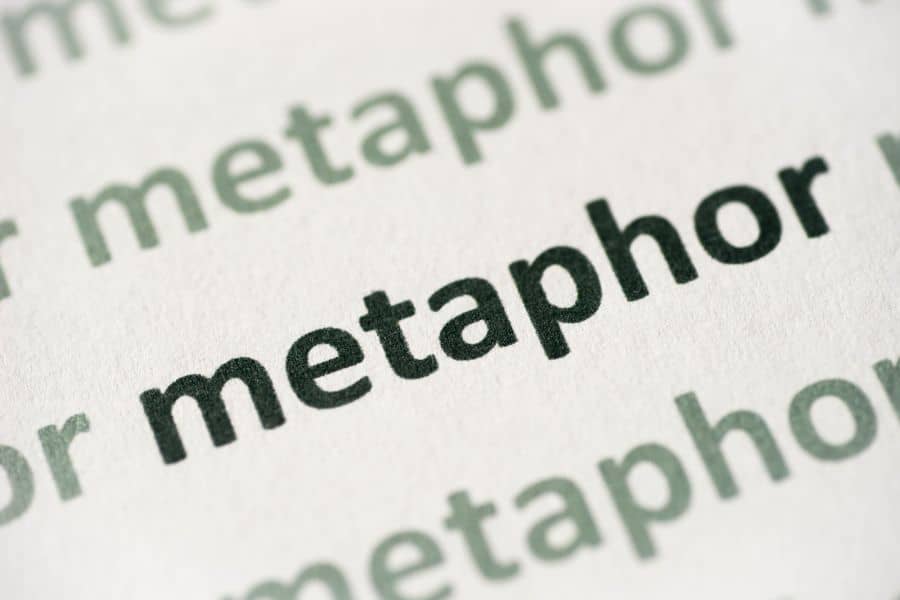
For example:
“Love is a fruit in season at all times and in reach of every hand.” — Mother Teresa
Love is not a fruit; however, the meaning of the comparison is easily understood.
Here’s another example:
“She was the black sheep of the family.”
Illogical, right? But you get the meaning right away.
Okay, so that’s the definition of metaphor…
What is Figurative Language?
Figurative language is a technique that supercharges your reader’s imagination by taking a flat (or factual) statement and injecting it with life, color, or humor to make it more interesting.
It allows you to paint vivid pictures , punch home your meaning, and be more persuasive as a writer .
A metaphor is one of several figure-of-speech devices that uses figurative language.
Here’s an example:
“The first rays of sunshine gently stroked my face.”
We all know sunshine can’t literally stroke your face, but we can all relate to the sensation. The figurative language makes it more vibrant than something like, “the first rays of sunshine woke me up.”
This type of figurative language is known as “personification,” which uses human qualities (stroking) to better illustrate a non-human action or thing (the sunshine). It’s a technique often found in metaphors.
There are several other figures of speech that use figurative language, including similes , analogies , metonymy , and hyperbole — which are often confused with metaphors.
So, let’s clear that up for you…
What’s the Difference Between Metaphors and Similes, Analogies, or Hyperbole?
Simile Definition: A simile is the metaphor’s first cousin. Where a metaphor states that something is something else, a simile compares two different things by using “like” or “as.”
Example of Simile: “ Elderly American ladies leaning on their canes listed toward me like towers of Pisa.” — from ‘Lolita’ by Vladimir Nabokov
Difference Between Similes and Metaphors: A simile directly compares two things using “like” or “as” (“ he was mad as hell”) , while a metaphor implicitly states a comparison, without intending it to be taken literally (“ he was boiling mad”).
To the latter example: Obviously, he wasn’t boiling, or he’d be dead. But were he a kettle, his lid would be rattling and steam would be coming from his ears. That’s how mad he’d be!
Analogy Definition: An analogy is a turbo-powered simile. While a simile compares two different things, an analogy explains the similarities or relationships between two different things.
Example of Analogy: “Longbottom, if brains were gold, you’d be poorer than Weasley, and that’s saying something.” — from ‘Harry Potter and The Sorcerer’s Stone’ by J.K. Rowling
Difference Between Analogies and Metaphors: While a metaphor uses a word or phrase to represent an idea, an analogy uses narrative or comparisons to explain the idea.
Hyperbole Definition: Hyperbole is an exaggeration that is not intended to be taken literally. It’s most commonly used for emphasis, humor, or drama.
Example of Hyperbole: “I was helpless. I did not know what in the world to do. I was quaking from head to foot, and could have hung my hat on my eyes, they stuck out so far.” — from “Old Times on the Mississippi” by Mark Twain
Difference Between Hyperbole and Metaphors: There is a gray area between the two and it’s often debated. But here are the facts: Hyperbole always uses exaggeration, whereas metaphors sometimes do.
If a metaphor is clearly an exaggeration, it can be described as a hyperbolic metaphor. An example would be, “cry me a river.” Obviously, no one can possibly shed that many tears.
On the other hand, “your suitcase weighs a ton” is hyperbole (not a metaphor).
What are The Different Types of Metaphors?
- Common Metaphors (aka a Direct Metaphor, Primary Metaphors, or Conventional Metaphors)
Implied Metaphors
Extended metaphors (aka a sustained metaphor), dead metaphors, mixed metaphors, sensory metaphors.
Google “types of metaphors” and you’ll get hundreds of blog posts and scholarly articles with lists of metaphors ranging from 3 to 20+ types (see: conceptual metaphor, cognitive metaphors, generative metaphors, etc.).
Focus on the 6 most common types of metaphors:
Common Metaphors (aka a Direct Metaphor, Primary Metaphor, Simple Metaphor, or Conventional Metaphor)
These are the easiest-to-spot metaphors.
A common metaphor (or standard metaphor, simple metaphor, etc.) is a comparison where the link can be easily made and directly understood.
Example sentence:
“He was a fish out of water at his new school.”
We know immediately what the writer means, even though it’s illogical to compare a school student to a fish.
Vincent Van Gogh’s “conscience is a man’s compass” is another example. Illogical, but we understand the meaning.
Other examples of common metaphors are “night owl”, “cold feet”, “beat a dead horse”, “early bird”, “couch potato”, “eyes were fireflies”, “apple of my eye”, “heart of stone”, “heart of a lion”, “roller coaster of emotions”, and “heart of gold.”
Implied metaphors force you to use your imagination. This kind of metaphor doesn’t make a direct comparison, which is easy to spot. Instead, it makes an implied comparison. A common metaphor is:
“She was a dog with a bone”
The dog-like comparison is stated.
“She tucked her tail between her legs and ran away”
On the other hand, the above is an implied metaphor — the comparison to a dog is implied but not stated outright.
Extended metaphors can be direct or implied, but create a greater emphasis with the comparison they’re making thanks to their extended length.
They can continue for several sentences, several paragraphs, or even longer.
(For example, George Orwell’s novella Animal Farm is considered by many to be an extended metaphor and allegory for the Russian Revolution of 1917.)
Extended metaphors are often used in poetry and literature where the author wants to convey more passion and commitment to a concept.
Here’s a famous example from “I Know Why the Cage Bird Sings” by Maya Angelou:
But a BIRD that stalks down his narrow cage Can seldom see through his bars of rage His wings are clipped and his feet are tied The caged bird sings with a fearful trill And his tune is heard on the distant hill for The caged bird sings of freedom.
And here’s an extended metaphor from “Hope is the Thing With Feathers” by Emily Dickinson:
Hope is the thing with feathers That perches in the soul And sings the tune without the words And never stops at all.
A dead metaphor is a figure of speech that has been around so long or is so overused, it’s no longer effective.
Phrases like “it’s raining cats and dogs” , “melting pot” , and “you are the light of my life” have morphed from metaphors into trite banalities and should be avoided.
Mixed metaphors are when two or more inconsistent metaphors get jumbled together — often with humorous consequences.
If it’s used intentionally, a mixed metaphor can be an effective communication technique. But in the wrong hands, a mixed metaphor can become a jumbled mess.
Former British soccer manager, Stuart Pearce, gave us this gem:
“I can see the carrot at the end of the tunnel.”
Sensory metaphors use figurative language to appeal to our senses — sight, sound (example: onomatopoeia ), smell, taste, or touch. As such, they’re immediately familiar and evocative.
“His voice was silky smooth.”
“Her smile lit up the room.”
Up to this point, you’ve already seen 10+ metaphor examples as we’ve explained the different types of metaphors and gone over several definitions.
Now, let’s get to the meat of the post.
Here are 41 more examples of metaphors from content marketing, English literature, great poems, speeches, movies, television shows, songs, and more:
Metaphor Examples from Content Marketing
As a content marketer, you fight a constant battle for attention. You need your words to leap off the page and galvanize your readers into action.
Using metaphors is a great way to do that.
Especially if you weave the metaphorical theme through your post. It helps give your writing a more intriguing creative tone . It makes your message sticky and memorable.
Take these examples of metaphors from some of the internet’s best content marketing blogs:
All these metaphor examples paint a vivid picture you can see, hear, or even taste. Some of them contain both metaphors and similes, some are extended metaphors, and some are sensory metaphors.
But none of them are dead metaphors.
Good metaphors are powerful even when you’re tackling a relatively mundane subject matter, like hiring copywriters, technical writers, or social media managers.
So, imagine how exciting metaphors can be in the hands of great fiction and literary writers whose subject matter can roam anywhere they darn well please.
Let’s look at a few such examples…
Examples of Metaphors in Literature
Metaphors in literature have been around for centuries.
They have cemented glorious stories and ideas into our minds. They have made the words on the page come alive and frolic through our imagination.
Let’s start with the king of literary terms and metaphors:
Hands up who doesn’t know these famous lines by William Shakespeare?
You’ll find them in every post and article about metaphors, literary devices , literary techniques, or figurative language, because it’s a classic extended metaphor example that’s hard to beat.
Here’s another one:
“Romeo and Juliet” is chock full of love metaphors. Nothing less than the fair sun and envious moon could express the depth of Romeo’s emotional state at that moment.
Imagine if he had been factual and said, “What light through yonder window breaks? Oh look, it’s Juliet heading for the bathroom”.
Shakespeare’s magnificent metaphors (and his celebrated examples of irony ) have wormed their way into our modern, everyday language and today we can recite them without a second thought.
Like these examples:
- “A horse, a horse. My kingdom for a horse!” — from Richard III
- “Shall I compare thee to a summer’s day?” — from Sonnet 18
- “Parting is such sweet sorrow…” — from Romeo and Juliet
- “All that glitters is not gold…” — from The Merchant of Venice
- “Why, then, the world’s mine oyster…” — from The Merry Wives of Windsor
I bet you didn’t know that last one was by Shakespeare.
Metaphors are also used throughout the Bible:
In fact, the Bible is a hotbed of metaphors, similes, and other types of figurative language:
- “I am the way, the truth and the life.” — John 14:6
- “You are the Father, we are the clay and You our potter; and all of us are the work of Your hand.” — Isaiah 64:8
- “Jesus said to them, ‘I am the bread of life; he who comes to Me will not hunger, and he who believes in Me will never thirst.” — John 6:35
We can find great metaphor examples in recent works of literature too:
That’s a formidable metaphor. This one’s a little sweeter:
And this one pulls no punches:
Ouch! Poor Matilda.
Or how about metaphor poems? Here’s an extract from a poem written when the author thought she might be pregnant:
Yikes! Can’t you feel Sylvia’s swollen discomfort? Perhaps it was just as well she turned out not to be pregnant after all.
This one sentence manages to fit in two different comparisons, words/crumbs and feast/mind. Impressive.
Metaphor Examples from Famous Speeches
Famous metaphors are found in great speeches throughout history.
Notable statesmen and leaders know they need to capture the hearts and minds of their audience, and nothing does that better than a slam-dunk metaphor. Like these:
Examples of Metaphors from Pop Culture
Metaphors don’t always have to be profound or literary. In the hands of song, TV, and movie writers; metaphors are often light, whimsical, and funny (or sad) .
But, they’re always entertaining.
Songwriters turn to metaphors because it allows them to be more creative, expressive, and raw with their lyrics. Metaphors in songs are designed to be felt.
Here are a few lyric examples:
In TV and movies, metaphors are often used as a device to handle taboo subjects such as sex or bodily parts. If you dress them up in comedic banter, it makes them more acceptable (and even funny).
The TV show Seinfeld was masterful at this:
And next time you go to the movies, watch out for an entire metaphorical theme lurking behind the scenes:
Now that we’ve looked at numerous metaphor examples, let’s go over some practical tips that’ll help you use metaphors in your own creative writing.
How to Use Metaphors to Supercharge Your Writing
- Use Metaphors in Your Headlines
- Make an Entire Post or Article Metaphorically Themed
- Use Metaphors to Make Facts and Figures Come to Life
- Be Sure to Use Metaphors Relevant to Your Audience
- Use of Metaphors to Make Dull Ideas Sparkle
- Metaphors Don’t Have to Be Written (Or, Get Creative With Metaphorical Images)
- Avoid the Cliches and Don’t Overdo Your Metaphor Quota
1. Use Metaphors in Your Headlines
We all know that headlines are the most important part of your post. If your headline doesn’t grab your reader’s attention, the rest of your post will be dead in the water.
So, what better place to slip in a nifty metaphor than in your headline? Like so:
- “Toy Story 4 is a Salute to Parents of Grown Children” — from Nature Moms
- “Win the War on Debt: 80 Ways to be Frugal and Save Money” — from Art of Manliness
2. Make an Entire Post or Article Metaphorically Themed
This is a great way to bring a subject to life or make a complex idea more easily understood. Here’s how:
First, take your subject and think of a second concept you could align it to. Let’s say your subject is “how to write a content brief,” which involves a formula and process — a bit like cooking.
So, let’s use that as your second concept.
Now start brainstorming words and ideas that can be applied to each concept separately:
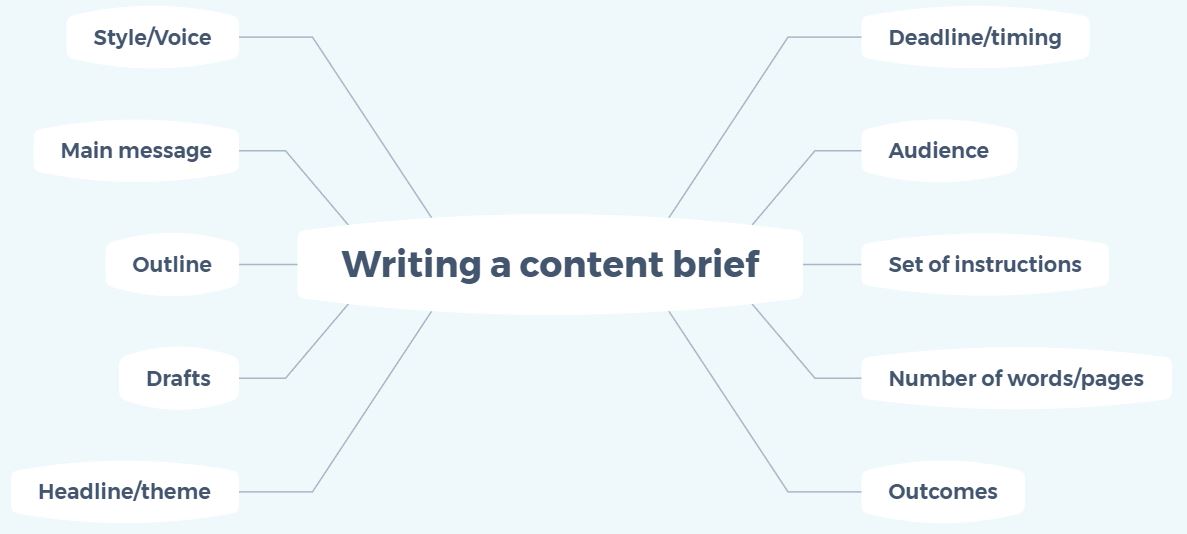
Next, look at your two lists and identify words or ideas that might overlap:
- “Set of instructions” and “recipes”
- “Audience” and “diners”
- “Outcomes” and “end result”
- “Style/voice” and “secret herbs and spices”
- “Outline” and “ingredients”
Can you feel a theme coming on?
3. Use Metaphors to Make Facts and Figures Come to Life
Data. Facts and Figures. We all know they’re important to substantiate your arguments, but on their own they can be meaningless and, to be honest, downright boring.
If I told you the circumference of the earth was 24,901 miles, you’d probably yawn.
But if I said the circumference of the earth was 801,500 Olympic size swimming pools laid back to back, it paints a much more relatable picture.
Think about the way we teach children how to add and subtract. We say, “if I give you three apples and take away one, how many are you left with?”
We are no different as adults. Our brains process facts and figures more effectively when they are anchored to relatable imagery or a concrete idea.
4. Be Sure to Use Metaphors Relevant to Your Audience
Think about who you are writing for and the context of your subject matter. If your post is aimed at teenage girls, you probably wouldn’t use a war analogy.
On the other hand, writers in the self-improvement niche often use metaphors related to battles as we strive to conquer our demons and make changes in our lives.
Use metaphors that are relevant to the times we live in and changes in our society and culture. Think about the age and generational context of your target audience. If they are young, don’t use outdated or old-fashioned metaphors that will leave them cold.
5. Use of Metaphors to Make Dull Ideas Sparkle
Like it or not, there’s probably going to come a time when you find yourself having to write about something dull. (And if you write for clients , there definitely will come a time when you’re bored to tears.)
That’s when metaphors become the writer’s best friend.
Metaphors allow you to hold your audience’s attention by shifting their focus away from the boring bits onto something far more imaginative and creative. Comparing religion, art, and science to branches on a tree, as Albert Einstein once did, is a good example.
Let’s face it, a content audit is not the most riveting subject matter, but Kristina manages to bring it to life by comparing audits to clearing up other people’s “icky detritus” after the winter snow has melted.
6. Metaphors Don’t Have to Be Written (Or, Get Creative With Metaphorical Images)
Metaphors don’t have to be limited to text. You can make your point just as powerfully — and faster — with a visual metaphor.
In blogging, no one does metaphorical illustrations better than Henneke Duistermaat and her hand-drawn “Henrietta” cartoons.
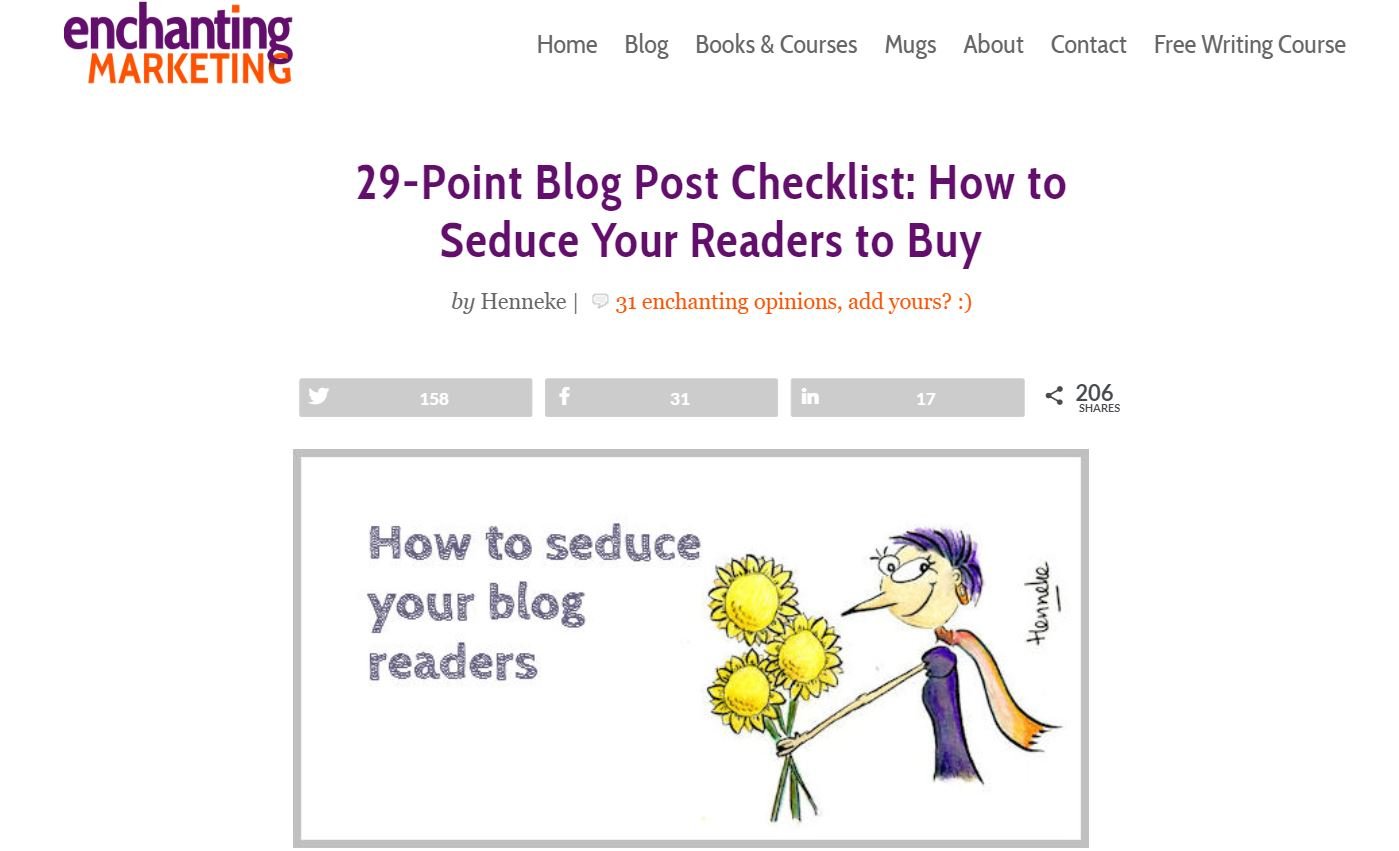
We can’t all be talented artists like Henneke, but we can find entertaining or vivid imagery that represents our message.
When you’re searching for the right image on sites like Unsplash and Gratisography , remember not to think of the literal meaning. Think metaphorically.
Let’s say you want to write a post on writer’s block. The obvious image would be something like this:
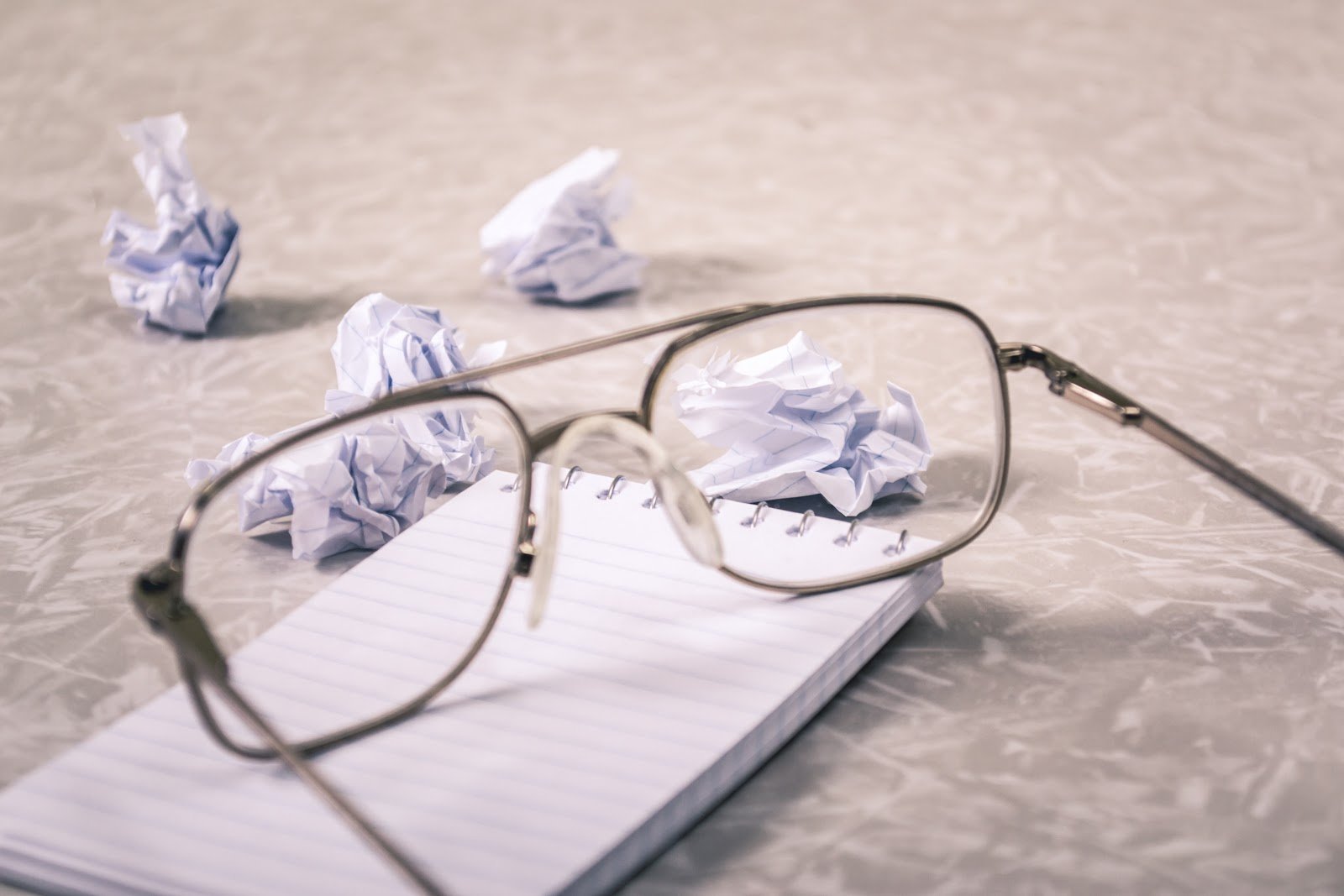
But that’s too obvious. What we need is a metaphor for writer’s block .
What emotions would you compare to writer’s block? Emptiness, fearfulness, loneliness, frustration, feeling trapped?
Look for images that capture one or more of those feelings. Like this:
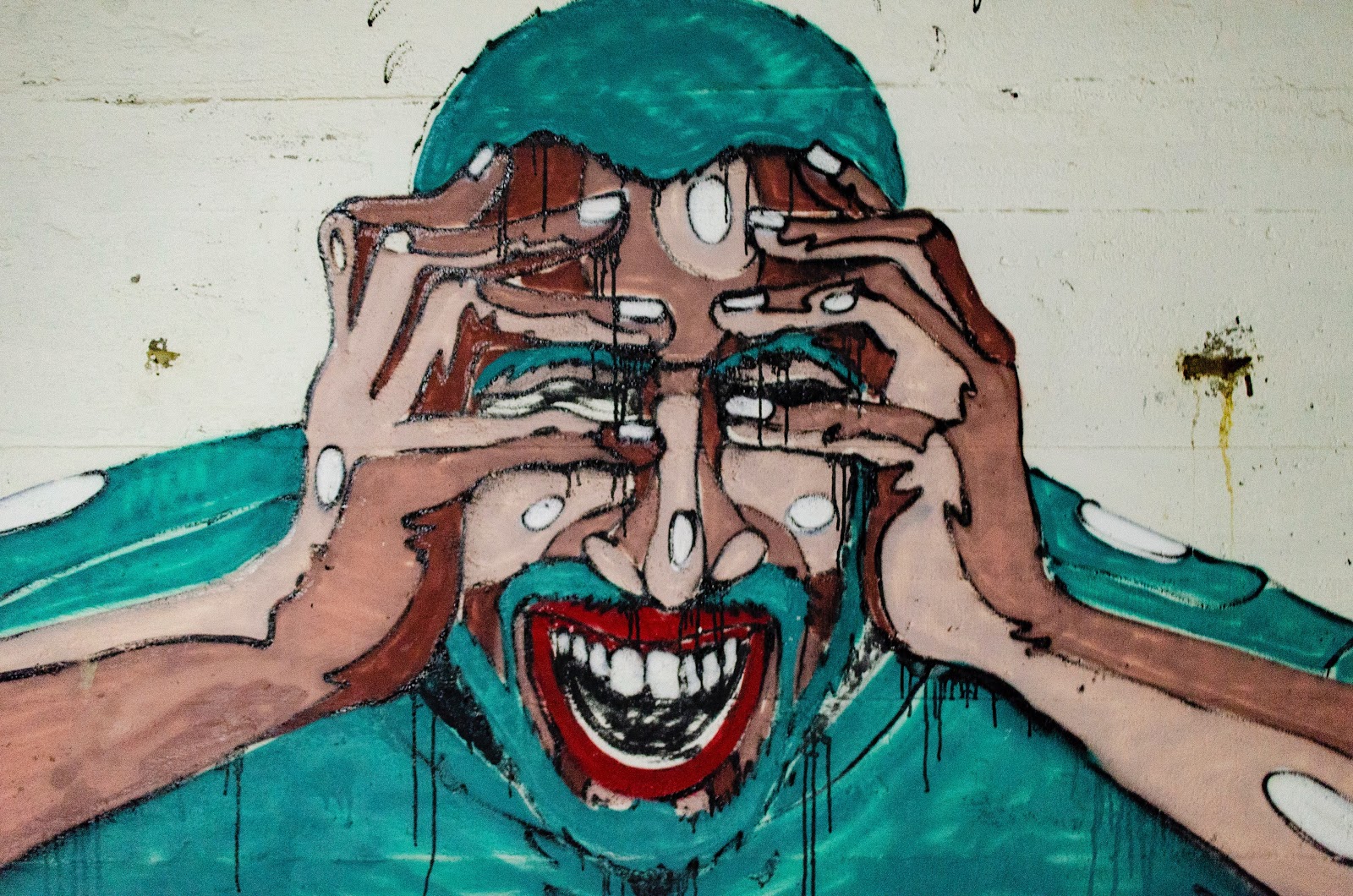
Which of those two images is going to attract more attention and add more spice and character to your blog post?
7. Avoid the Cliches and Don’t Overdo Your Metaphor Quota
Finally, here are a few what not to-dos:
- Don’t overuse metaphors. Opt for simple metaphors (or sprinkle a few well-placed metaphors for the sake of clarity or persuasion). Too many will weigh your post down and start to sound messy.
- Don’t force metaphors into your writing. It’s like overusing adjectives or flowery words. Readers will spot them a mile away.
- Avoid the overly obvious or dead metaphors. They tend to be clichéd and have lost their ability to conjure up a visual image. Examples are “going belly up,” “kicking the bucket,” and “you light up my life.”
You Just Read the Definitive List of Metaphor Examples. Ready to Unleash Their Power?
Metaphors are all around us.
They sneak into everyday life and everyday speech ( “the traffic was a nightmare” ). They help us form impressions of people and situations ( “he fought cancer and won” ).
But most of all — as I hope these examples of metaphors have shown you — they are possibly the most powerful literary device in a writer’s toolbox. (Although, I’m sure alliteration would beg to differ .)
Metaphors are a zap of electricity between you and your audience — a jolt that’s often the difference between a lackluster sentence and a sparkling gem of persuasive genius.
So, next time you want to compel your readers to take action, savor your words, or quickly grasp your meaning, use a metaphor.
Literary Devices , Writing
A certified copywriter with more than 25 years of experience, Mel Wicks researched metaphors, similes, analogies, and hyperbole for hours when writing this post.
The ultimate toolkit for becoming one of the highest-paid writers online. Premium training. Yours for free.

Written by Mel Wicks
Latest from the blog.

How to Increase Website Traffic (& Get 200+ Million Visitors)

Copywriter Salary: Hourly, Daily, Weekly, & Monthly Rates (2024)

10 Social Media Campaigns to Inspire Your Own in 2024

With over 300k subscribers and 4 million readers, Smart Blogger is one of the world's largest websites dedicated to writing and blogging.
Best of the Blog
© 2012-2024 Smart Blogger — Boost Blog Traffic, Inc.
Terms | Privacy Policy | Refund Policy | Affiliate Disclosure
Powerful Examples of Similes and Metaphors to Improve Your Writing
Understanding similes, simile definition, examples of similes, tips for using similes, understanding metaphors, metaphor definition, examples of metaphors, tips for using metaphors, applying similes and metaphors in your writing, enhancing description, creating imagery, adding emotion and depth, similes and metaphors in literature, classic literature, modern literature, similes and metaphors in pop culture, movies and tv, advertising.
Similes and metaphors are powerful tools that can help you take your writing to the next level. They allow you to create vivid imagery and evoke emotions in your readers, making your work more engaging and memorable. In this blog, we'll explore simile and metaphor examples, along with tips on how to use them effectively in your writing. Let's dive in!
Similes are a type of figurative language that compare two different things using the words "like" or "as." They help your readers better visualize and understand the ideas you want to convey. Let's start with the basics:
A simile is a figure of speech that compares two unlike things using the words "like" or "as." This comparison highlights a specific quality or characteristic shared by the two things, making the description more vivid and relatable. For example:
- Her smile was as warm as the sun on a summer day.
- He ran like the wind, leaving everyone else behind.
Similes can add depth and color to your writing, making it more engaging. Here are some more simile examples to inspire you:
- Her eyes sparkled like stars in the night sky.
- He was as stubborn as a mule, refusing to change his mind.
- Their love was as deep as the ocean.
- The baby's laughter was as sweet as the sound of a music box.
- The room was as silent as a graveyard at midnight.
To make the most of similes in your writing, keep these tips in mind:
- Be specific: Choose comparisons that paint a clear and vivid picture for your readers.
- Be relevant: Make sure the simile adds value to your writing and supports the point you're trying to make.
- Avoid clichés: Steer clear of overused similes, like "as busy as a bee" or "as cool as a cucumber." Instead, get creative and come up with your own unique simile and metaphor examples.
Metaphors, like similes, are a form of figurative language that can enrich your writing by creating strong imagery and conveying emotions. However, they differ from similes in one key aspect—metaphors don't use "like" or "as" for comparison. Instead, they directly state that one thing is another. Let's take a closer look:
A metaphor is a figure of speech that describes an object or action by equating it with something else, without using "like" or "as." This comparison helps to emphasize a particular quality or characteristic of the object or action. For example:
- Her voice was music to his ears.
- Time is a thief that steals our moments away.
Using metaphors in your writing can create powerful imagery and make your words more memorable. Here are some metaphor examples to spark your creativity:
- All the world's a stage , and we are merely players.
- My thoughts are swirling leaves in the wind of my mind.
- Her heart is a garden blooming with kindness.
- The sun is a golden coin tossed into the sky.
- His words were daggers that pierced her heart.
When incorporating metaphors into your writing, consider these guidelines:
- Be original: Avoid clichéd metaphors that your readers have likely encountered before. Create your own fresh and unique metaphor examples.
- Stay focused: Ensure that your metaphor is relevant to the point you're trying to make and enhances the overall message.
- Keep it simple: While it's tempting to craft complex metaphors, remember that clarity is key. Keep your metaphors straightforward and easy to understand.
Similes and metaphors can add depth, emotion, and vivid imagery to your writing. When used effectively, they can elevate your work and create a lasting impression on your readers. Let's explore some ways to incorporate similes and metaphor examples into your writing:
Both similes and metaphors can help you describe characters, settings, and emotions more vividly. By comparing an object or action to something else, you can create a more striking image in your reader's mind:
- His eyes were as cold as ice when he looked at her. (simile)
- The city was a sleeping giant waiting to be awakened by the first rays of sunlight. (metaphor)
By comparing objects, actions, or emotions to something unexpected, similes and metaphors can paint vivid pictures in your reader's mind. This can enhance the overall reading experience and make your words more memorable:
- The clouds were like cotton candy floating in the sky. (simile)
- Her laughter was a symphony of joy that filled the room. (metaphor)
Similes and metaphors can be powerful tools for expressing emotions and adding depth to your writing. By choosing the right comparisons, you can evoke specific feelings or create a particular mood:
- She felt as if a thousand butterflies were fluttering in her stomach. (simile)
- Grief was a heavy stone that weighed her down. (metaphor)
Remember, the key to successful use of similes and metaphor examples is to be creative, clear, and relevant to the message you want to convey. By incorporating these techniques in your writing, you can create a stronger connection with your readers and leave a lasting impression.
Similes and metaphors have been used by writers throughout history to create memorable, evocative works. Let's look at some examples of similes and metaphors in both classic and modern literature, as well as poetry.
In classic literature, similes and metaphors have been used to create rich descriptions and convey emotions. Here are a few powerful examples:
- In To Kill a Mockingbird by Harper Lee: "People generally see what they look for, and hear what they listen for, and they have the right to subject their children to it all."
- In Great Expectations by Charles Dickens: "Suffering has been stronger than all other teaching, and has taught me to understand what your heart used to be."
- In Moby Dick by Herman Melville: "The sun hides not the ocean, which is the dark side of this earth, and which is two thirds of this earth."
Modern literature also employs similes and metaphors to create vivid imagery and evoke emotions. Here are some examples:
- In The Fault in Our Stars by John Green: "My thoughts are stars I cannot fathom into constellations."
- In The Hunger Games by Suzanne Collins: "Hope is the only thing stronger than fear."
- In Harry Potter and the Philosopher's Stone by J.K. Rowling: "The castle was a vast maze of ramparts, turrets, and halls."
Poetry often relies heavily on similes and metaphors to create powerful imagery and convey emotions. Here are some examples from famous poets:
- In "The Road Not Taken" by Robert Frost: "Two roads diverged in a wood, and I— / I took the one less traveled by, / And that has made all the difference."
- In "A Red, Red Rose" by Robert Burns: "O my Luve is like a red, red rose / That's newly sprung in June; / O my Luve is like the melody / That's sweetly played in tune."
- In "I Wandered Lonely as a Cloud" by William Wordsworth: "For oft, when on my couch I lie / In vacant or in pensive mood, / They flash upon that inward eye / Which is the bliss of solitude."
By examining simile and metaphor examples in literature, you can gain inspiration and insight into how these powerful devices can enhance your own writing and create a lasting impact on your readers.
Similes and metaphors aren't just limited to literature—they also play a significant role in popular culture. Let's explore some examples of similes and metaphors in music, movies, TV shows, and advertising to see how these devices add depth and meaning to our everyday entertainment.
Music often uses similes and metaphors to create vivid imagery and convey emotions. Here are a few examples from popular songs:
- In "Firework" by Katy Perry: "Do you ever feel like a plastic bag / Drifting through the wind, wanting to start again?"
- In "I Will Always Love You" by Whitney Houston: "If I should stay / I would only be in your way / So I'll go but I know / I'll think of you every step of the way."
- In "Let It Be" by The Beatles: "When the brokenhearted people living in the world agree / There will be an answer, let it be."
Movies and television shows often use similes and metaphors to create memorable scenes and lines. Here are some examples:
- In Forrest Gump : "Life is like a box of chocolates; you never know what you're gonna get."
- In The Dark Knight : "You either die a hero, or you live long enough to see yourself become the villain."
- In Game of Thrones : "When you play the game of thrones, you win or you die. There is no middle ground."
Advertisers often use similes and metaphors to create catchy slogans and memorable ads. Here are some examples:
- In Nike's slogan: "Just do it."
- In McDonald's slogan: "I'm lovin' it."
- In Apple's "Think Different" campaign: "Here's to the crazy ones. The misfits. The rebels. The troublemakers."
By examining simile and metaphor examples in pop culture, you can see how these powerful devices add depth and meaning to our everyday entertainment, making them more memorable and engaging for audiences.
If you're eager to expand your illustration skills and learn how to create intricate designs using simple shapes, we highly recommend Juliet Schreckinger's workshop, ' Composing Complex Illustrations using Basic Shapes '. This workshop offers valuable techniques and tips to help you master the art of composing complex illustrations with basic shapes, taking your creativity to new heights.

Live classes every day
Learn from industry-leading creators
Get useful feedback from experts and peers
Best deal of the year
* billed annually after the trial ends.
*Billed monthly after the trial ends.
ThinkWritten
What Is A Metaphor? Examples Of Metaphors In Writing
Today we’ll look at what a metaphor is, share examples of metaphors in writing, and give some tips for how to use metaphors when writing.
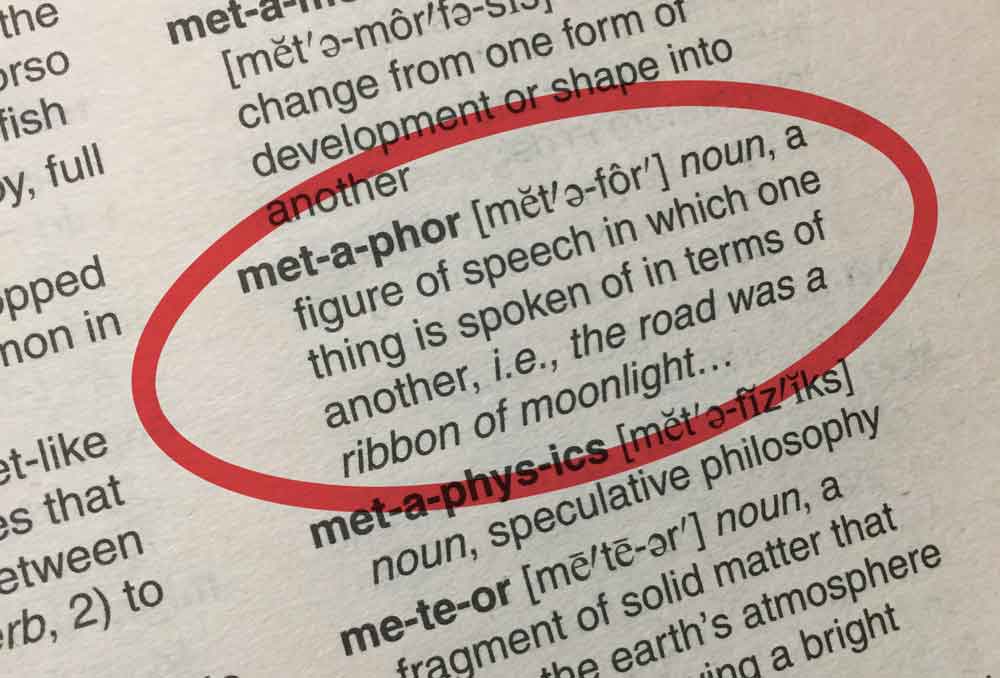
We may receive a commission when you make a purchase from one of our links for products and services we recommend. As an Amazon Associate we earn from qualifying purchases. Thank you for support!
Sharing is caring!
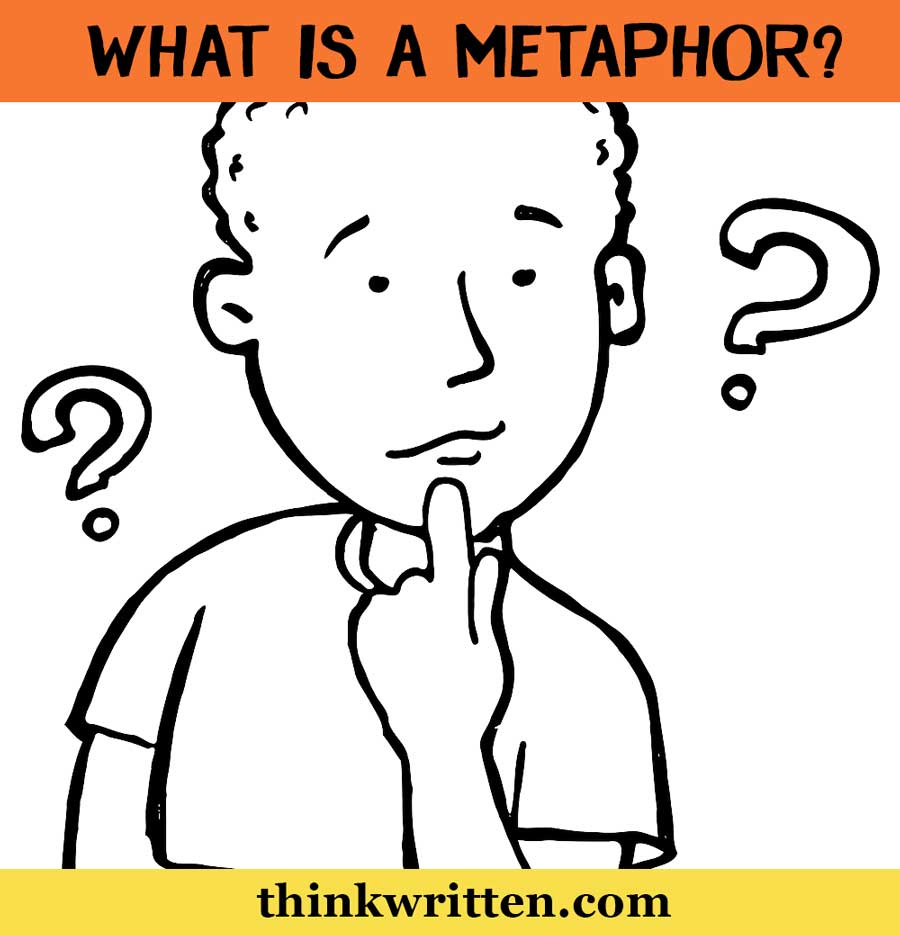
Metaphors are some of the most effective tools for adding color and emphasis to your writing. Although they serve many of the same functions as similes, they are generally much more subtle and poetic.
In fact, the Ancient Greek philosopher Aristotle thought of metaphors so highly that he considered their mastery “a sign of genius.”
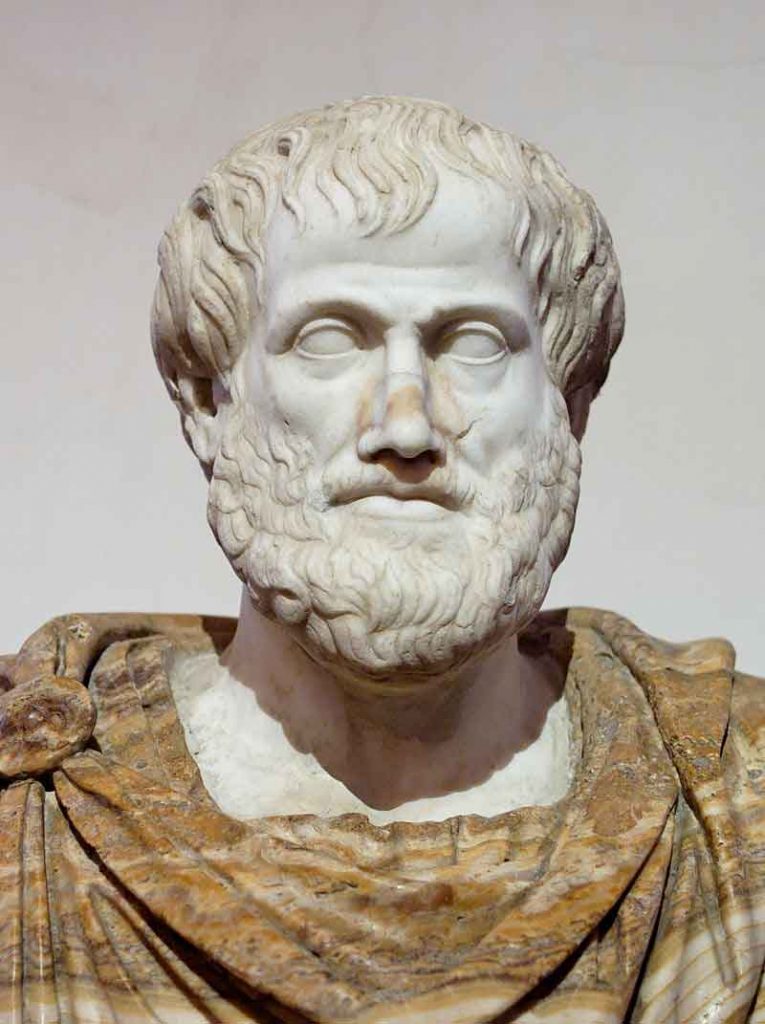
Metaphors defined
Metaphors are figures of speech in which one thing is spoken of in terms of another.

Frequently, metaphors compare people or events to inanimate objects or natural occurrences. Even when the two things being compared are seemingly unrelated to each other, the use of a metaphor makes the reader understand that the comparison isn’t literal.
The word “metaphor” comes from the 16 th -century French word métaphore , which in turn is derived from the Latin word metaphora , which means “carrying over” or “to carry across.” The word metaphor, therefore, suggests the carrying over of a shared characteristic or quality across two different things.
See Related Post: Allusion in Writing
The purpose of metaphors

The most basic function of a metaphor is to impart a bit of emphasis and color to what a writer is trying to express. For instance, describing someone as having a “sea of knowledge” means that the writer considers that person extremely wise or knowledgeable.
In this particular example, the “sea” and “knowledge” obviously do not have a literal relationship with each other. Even so, they share the qualities of being large or immense, as well as being difficult to measure. By using them both in a comparative statement, most readers would understand that the writer is alluding to the person’s vast and immeasurable knowledge.
Why are metaphors so important?
Using metaphors are useful for adding detail to your writing and making it more powerful. They can impart essential sensory details and make your story or message more interesting to the reader. Used effectively, metaphors can make your words more real and give your readers a more meaningful connection to a character or scene.
Metaphors also spur on the imagination of your readers, enabling them to form a new and more in-depth understanding of familiar ideas. They can also help readers better understand a topic that would otherwise be vague or confusing to them.
Things to keep in mind when using metaphors
One of the risks associated with using metaphors is the tendency for readers to be confused about what the writer is trying to express.
Often, there is a need to examine the context in which the metaphor is used. Depending on the particular usage, a metaphor could affect the meaning of the phrase in different ways.
It is also worth noting that some writers may include a phrase that is commonly used as a metaphor without necessarily comparing two things with each other.
When describing someone as having a “broken heart”, for example, the writer may not necessarily be alluding to the subject’s heart. Instead, the phrase “broken heart” may simply be used because of its familiarity as a figurative expression.
Examples of metaphors

Metaphors are fairly common in everyday language, so much so that most of us don’t even give them a second thought. Many of the expressions that we commonly use in written and spoken language are, in fact, metaphors.
Among these are phrases such as “heart of gold”. Some metaphors may also refer to other people in unflattering terms such as a “snake”, a “pig”, or a “shark”.
Here are some more common examples:
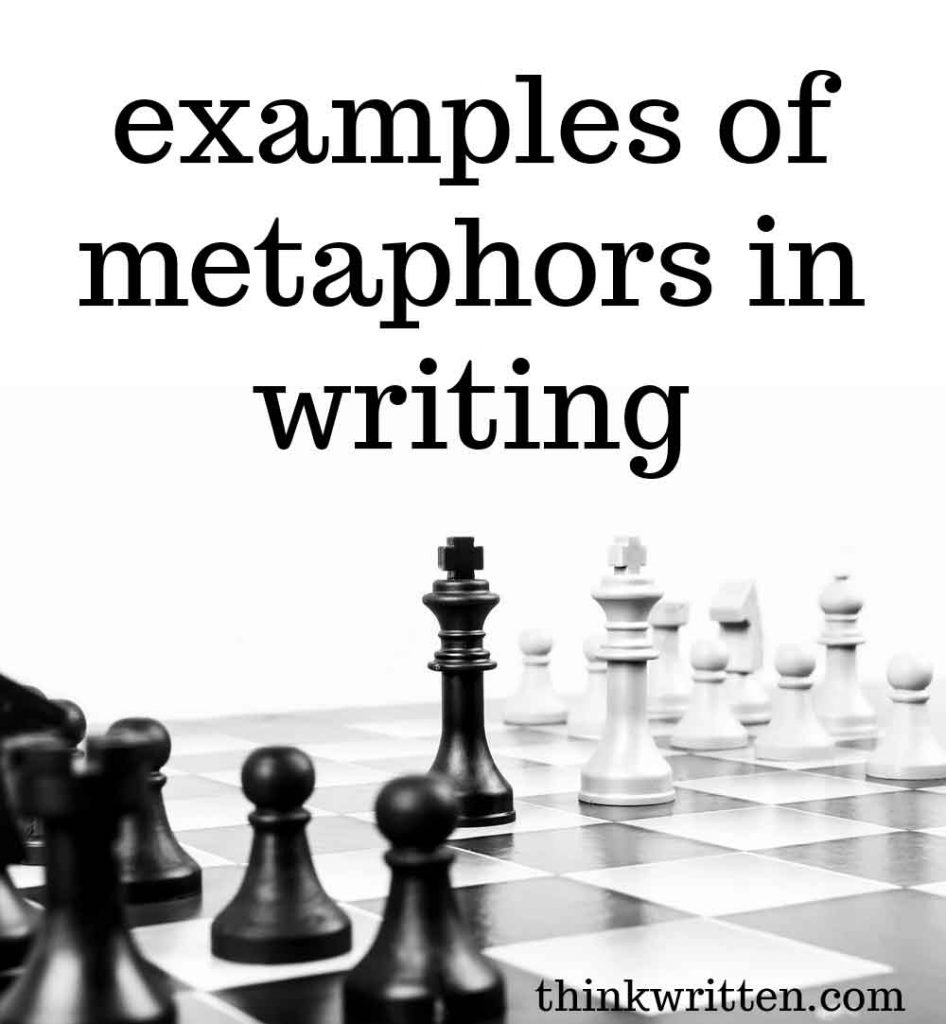
“All religions, arts, and sciences are branches of the same tree.” – Albert Einstein
In this particular example, Einstein obviously wasn’t talking about horticulture. But his association of religion, art, and science with a tree suggests that he believed that they were all part of a bigger whole.
“The running back carried the entire team on his back the whole game!”
This is commonly heard in sports where metaphors are frequently used. Instead of visualizing an entire team being carried on a single player’s back, it would be more accurate to get a picture of the player performing more than is typically expected.
“You were a total rock star at the last sales meeting!”
This suggests that the object of the metaphor performed exceptionally well during the last meeting. Rock stars are often seen as larger-than-life characters capable of astounding feats. By being compared to a rock star, the object is considered as having performed outstandingly well.
The use of metaphors is rife in literature throughout the ages. In William Shakespeare’s Romeo and Juliet , the following line is written:
“But soft, what light through yonder window breaks? It is the east, and Juliet is the sun!”
Considered one of the most famous metaphors in the English language, it compares Juliet to the sun, suggesting the radiance of her beauty. The absence of comparing words such as “like” or “as” further emphasize how Romeo was impressed with Juliet.
In Khalil Gibran’s Sand and Foam , we read the following example:
“Our words are but crumbs that fall down from the feast of the mind.”
In many ways, this particular metaphor is quite similar to other commonly used–and abused–metaphors such as “the tip of the iceberg” or “a mere shadow.” These metaphors suggest that what we are seeing is only a fraction of what remains hidden or concealed.
But unlike those other metaphors that border on the cliché, Gibran’s sentence adopts a more creative and original approach. It also utilizes two different comparisons in one metaphor, by comparing “words” to “crumbs” and “mind” to “feast”. This usage makes the metaphor much more powerful and evocative to the reader.
The next example comes from Sylvia Plath’s Metaphors. Here, the sentence simply reads;
“I’ve eaten a bag of green apples.”
The simplicity of this particular example arguably makes the message more powerful once you figure out what the author is trying to express. But it also makes the metaphor a bit more difficult to comprehend. In fact, many of Plath’s poems–this one included–are rife with figurative language, much of which can be challenging to understand.
But the meaning of this particular metaphor can be deduced by knowing what the poem is about, which is Plath’s pregnancy. It is, therefore, safe to assume that the line alludes to morning sickness, the symptoms of which could be similar to consuming a bag of sour green apples.
Metaphors are common in pop culture as well. In Disney’s Aladdin , the following phrase is used:
“Seek thee out the diamond in the rough.”
This line is only one of many in the film that compares humans to jewels and gemstones. This particular example alludes to Aladdin as a “diamond in the rough”, suggesting that despite his rough and unpolished state, he could go on to achieve great things.
Finally, from singer Pink comes this line from her song God Is a DJ :
“God is a DJ, life is a dance floor, love is a rhythm.”
Again, this metaphor combines more than one comparison in a fairly lengthy phrase. As in Khalil Gibran’s Sand and Foam, this approach helps create a more powerful image.
In this case, it encapsulates the entirety of the world within the confines of a nightclub. And because the song is likely played in nightclubs, club-goers are presumably able to relate their more fleeting experience to loftier and more significant concepts.
As you can see, metaphors can add richness and color to what would otherwise be drab and straightforward writing. Learn how to utilize metaphors effectively, and you could add more depth and expression to your written work.
Do you have any questions about metaphors or examples of metaphors you are familiar with? Share your thoughts in the comments section below!
Eric Pangburn is a freelance writer who shares his best tips with other writers here at ThinkWritten. When not writing, he enjoys coaching basketball and spending time with his family.
Similar Posts
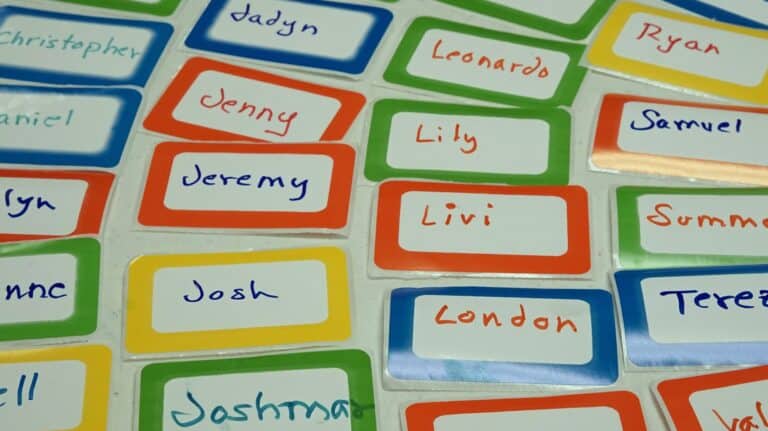
How to Name Your Characters

Allusion Examples and Why You Need Allusion in Your Writing

How to Outline a Novel Plot in 5 Easy Steps
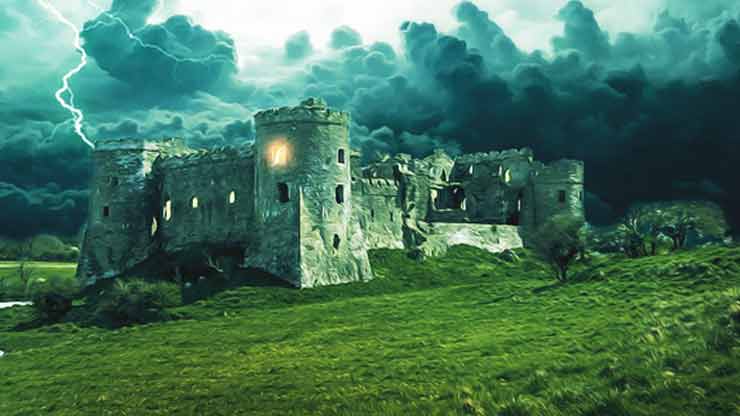
5 Signs of a Strong Novel Plot

6 Places to Find Poetry Writing Inspiration

What is a Deuteragonist?
Leave a reply cancel reply.
Your email address will not be published. Required fields are marked *
Save my name, email, and website in this browser for the next time I comment.
Writing Academy Blog
Writing Tips & Links

Using Metaphors in Creative Writing
What is a metaphor.
The term metaphor meant in Greek “carry something across” or “transfer,” which suggests many of the more elaborate definitions below:
| A comparison between two things, based on resemblance or similarity, without using “like” or “as” | most dictionaries and textbooks |
| The act of giving a thing a name that belongs to something else | Aristotle |
| The transferring of things and words from their proper signification to an improper similitude for the sake of beauty, necessity, polish, or emphasis | Diomedes |
| A device for seeing something in terms of something else | Kenneth Burke |
| Understanding and experiencing one thing in terms of another | John Searle |
| A simile contracted to its smallest dimensions | Joseph Priestly |
Related terms
| : A sustained metaphor. | The teacher descended upon the exams, sank his talons into their pages, ripped the answers to shreds, and then, perching in his chair, began to digest. |
| : A less direct metaphor. | John swelled and ruffled his plumage. (versus John was a peacock) |
| : The awkward, often silly use of more than one metaphor at a time. To be avoided! | The movie struck a spark that massaged the audience’s conscience. |
| : A commonly used metaphor that has become over time part of ordinary language. | tying up loose ends, a submarine sandwich, a branch of government, and most clichés |
| : A comparison using “like” or “as” | Her face was pale as the moon. |
| : The substitution of one term for another with which it is commonly associated or closely related. | the pen is mightier than the sword, the crown (referring to a Queen or King), hands (referring to workers who use their hands) |
| : The substitution of a part for the whole or vice versa (a kind of metonym). | give us this day our daily bread |
Why use metaphors?
- They enliven ordinary language. People get so accustomed to using the same words and phrases over and over, and always in the same ways, that they no longer know what they mean. Creative writers have the power to make the ordinary strange and the strange ordinary, making life interesting again.
- They are generous to readers and listeners; they encourage interpretation. When readers or listeners encounter a phrase or word that cannot be interpreted literally, they have to think—or rather, they are given the pleasure of interpretation. If you write “I am frustrated” or “The air was cold” you give your readers nothing to do—they say “so what?” On the other hand, if you say, “My ambition was Hiroshima, after the bombing,” your readers can think about and choose from many possible meanings.
- They are more efficient and economical than ordinary language; they give maximum meaning with a minimum of words. By writing “my dorm is a prison,” you suggest to your readers that you feel as though you were placed in solitary, you are fed lousy food, you are deprived of all of life’s great pleasures, your room is poorly lit and cramped—and a hundred other things, that, if you tried to say them all, would probably take several pages.
- They create new meanings; they allow you to write about feelings, thoughts, things, experiences, etc., for which there are no easy words; they are necessary. There are many gaps in language. When a child looks at the sky and sees a star but does not know the word “star,” she is forced to say, “Mommy, look at the lamp in the sky!” Similarly, when computer software developers created boxes on the screen as a user interface, they needed a new language; the result was windows. In your poems, you will often be trying to write about subjects, feelings, etc., so complex that you have no choice but to use metaphors.
- They are a sign of genius. Or so says Aristotle in Poetics: “[T]he greatest thing by far is to be a master of metaphor.” It is “a sign of genius, since a good metaphor implies an intuitive perception of the similarity in dissimilars.”
Creative ways to use metaphors
Most books give rather boring examples of metaphors such as my father is a bear or the librarian was a beast. However, in your poetry (and fiction for that matter) you can do much more than say X is Y, like an algebraic formula. Definitely play with extended metaphors (see above) and experiment with some of the following, using metaphors…
| as verbs | The news that ignited his face snuffed out her smile. |
| as adjectives and adverbs | Her carnivorous pencil carved up Susan’s devotion. |
| as prepositional phrases | The doctor inspected the rash with a vulture’s eye. |
| as appositives or modifiers | On the sidewalk was yesterday’s paper, an ink-stained sponge. |
| Scratching at the window with claws of pine, the wind wants in. | Imogene Bolls, “Coyote Wind” |
| What a thrill—my thumb instead of an onion. The top quite gone except for a sort of hinge of skin….A celebration this is. Out of a gap a million soldiers run, redcoats every one. | Sylvia Plath, “Cut” |
| The clouds were low and hairy in the skies, like locks blown forward in the gleam of eyes. | Robert Frost, “Once by the Pacific” |
| Little boys lie still, awake wondering, wondering delicate little boxes of dust. | James Wright, “The Undermining of the Defense Economy” |
- Grammar Checker
- Paraphrasing Tool
- Critique Report
- Writing Reports
- Learn Blog Grammar Guide Community Events FAQ
- Grammar Guide
Examples of Metaphors in Literature

By Allison Bressmer
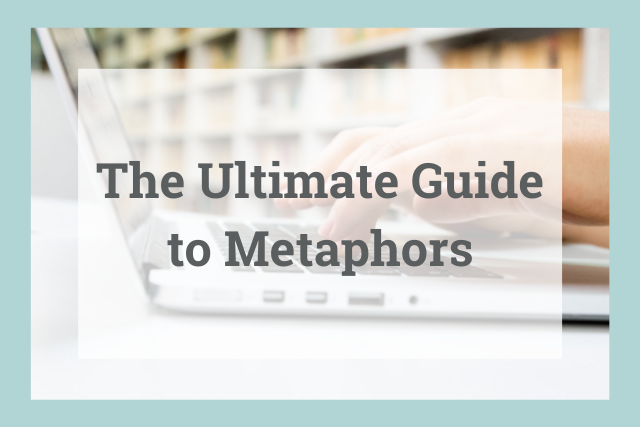
Though you may not have noticed, you have likely heard or used quite a few metaphors today. Perhaps you’ve said someone has a “heart of gold” or conversely, a “heart of stone” or called a lively child “a real firecracker!”
A metaphor makes a direct comparison between two things that are generally not related or similar, but share a specific quality or characteristic that is emphasized through the comparison.
While we may learn about metaphor most directly through poetry and literature, metaphors aren’t just for artists. They add color and carry meaning even in our everyday language.
What Is a Metaphor?
How is a metaphor different from a simile, why use metaphors, examples of types of metaphors, what is a mixed metaphor, how to use metaphors in your writing, examples of metaphors, why metaphors are powerful.
A metaphor is a type of figurative language . It is a figure of speech used to convey a message that goes beyond the literal meaning of their words.
Figures of speech are not intended to be taken literally.
A person can’t have a heart of gold or stone, and a child is a human, not an explosive!
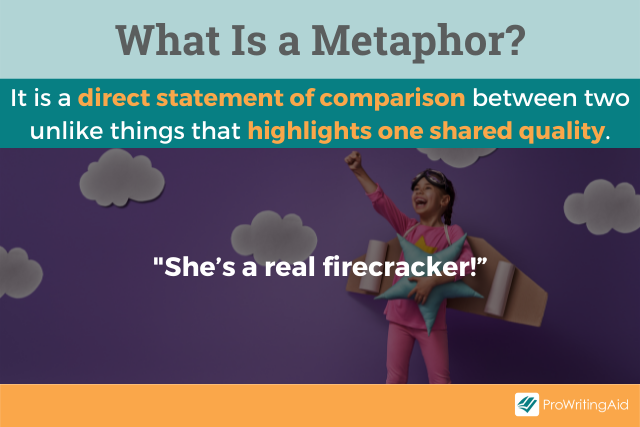
So what’s the point of the comparison then? The point is to go beyond literal meanings.
Gold is precious; it’s pure and valuable. A person with a heart of gold is sincere and kind—a purely good person who adds value to others’ experiences.
Stone is cold and hard. A person with a heart of stone shows no emotional tenderness or empathy—no softness or warmth in their personalities.
A firecracker is full of energy and vibrancy. That firecracker child is probably running around the house and full of sass!
A metaphor makes a direct comparison between two unlike things in order to highlight the one (or so) shared quality between those two things. A metaphor outright “calls” or “labels” that one thing as another thing: the heart is gold or stone; the child is a firecracker.
While a metaphor makes a direct comparison—it states that one thing is another thing—a simile makes its comparisons a little less directly by including the words like or as .
- Simile: She’s as fast as a cheetah!
- Metaphor: She’s a cheetah!

- Simile: Their relationship was like a tornado.
- Metaphor: Their relationship was a tornado.
Sometimes you might prefer the directness of a metaphor; other times a simile will carry your meaning more effectively. Some comparisons just work better as similes than metaphors and vice versa. Whatever works for your specific situation, metaphors and similes can bring creativity and intensity to your words and writing style.
There are plenty of reasons to use metaphors in your work!
1. To Add Creativity
Writers want to express ideas creatively. They want to draw readers into experiences or emotions. They want to describe characters or scenes or events with originality to keep their readers engaged.
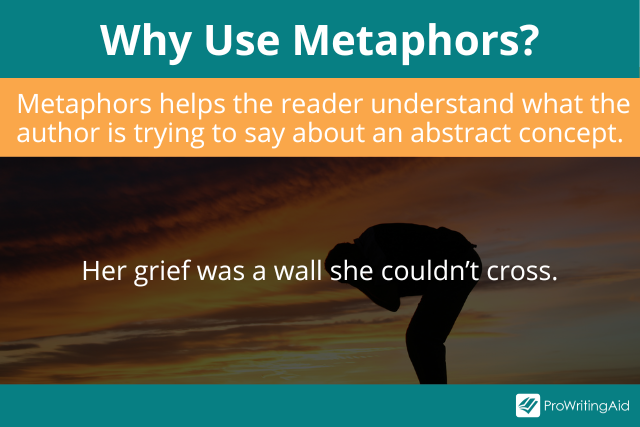
Sometimes, literal language just isn’t enough to get those jobs done. Or, maybe it can, but metaphor can do it better, with more intensity and vibrancy.
In Lucille Clifton’s poem “Miss Rosie,” the speaker, frustrated and angry by what Miss Rosie has become, calls her “you wet-brown bag of a woman.” I suppose the speaker could have said “Miss Rosie—you are useless” and still conveyed anger, but I doubt I would remember it. It’s kind of hard to forget that creative “wet-brown-bag” comparison.
2. To Bring Emotional Intensity
What statement conveys more feeling?
- I love you very much.
- My love for you is a raging fire.
Okay, perhaps my metaphor example is corny. But it is also more intense. Raging fire emphasizes the passion and heat and “out-of-controlness” that comes with being in love. It easily out-intensifies very much.
3. To Use the Power of Imagery
Each of the examples of metaphor used so far in this post have probably activated your senses. You can picture and perhaps even feel that cold heart of stone, or the pure, shining beauty of the heart of gold . You might have felt the heat of the fire and pictured its wild, red-hot flames.
4. To Provoke Thought
The meaning of a metaphor isn’t always glaringly obvious. You might have had to stop and think about the characteristics of a wet, brown bag before you could understand the speaker’s accusation in “Miss Rosie.” Once you stop and think, though, you can see the layers of meaning. A wet brown bag was once useful, but is now mushy, musty waste that’s good for nothing.
5. To Create Atmosphere
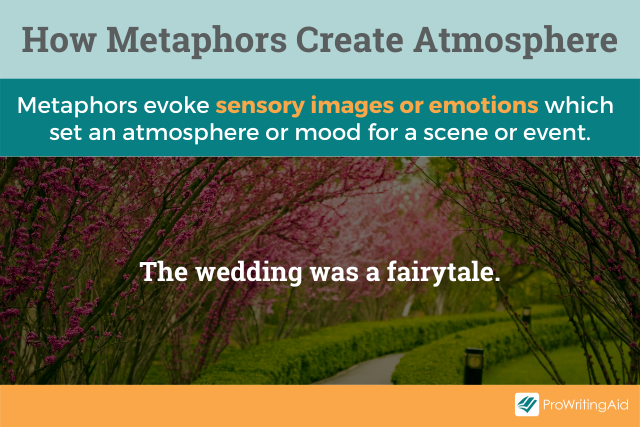
Sometimes, the sensory images or emotions evoked through metaphor can help set an atmosphere or mood for a scene or event, drawing audiences more deeply into the experience.
- The wedding was a fairytale.
The metaphor makes it easy to image a picture-perfect, enchanting celebration, full of happily-ever-after vibes.
- I finally found escape in the abandoned barn. The torrential rain was rapid machine-gun fire echoing threats of my destruction.
The metaphor adds to the danger of this moment. Not only has the person had to escape, but even the sound of the rain itself perpetuates the feeling that the character is under attack.
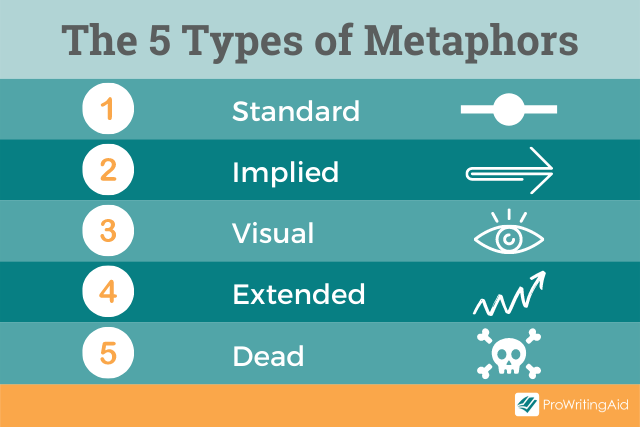
So far, the metaphors you’ve seen in this post have been standard metaphors . Standard metaphors simply make that direct comparison between two unlike things:
- Traffic was a beast today.
- That baby is a treasure!
However, standard is not the only type of metaphor. Here are some others:
Implied Metaphor
She hissed her warning— “Keep your mouth shut or I’ll shut it for you.”
In this case, no snake is mentioned, but the “hiss” implies the comparison of “she” to that dangerous, threatening creature.
Visual Metaphor
Visual metaphors show, rather than directly state, the comparison.
Does anyone remember the once-popular ad campaign that showed someone in a kitchen holding an egg and saying “this is your brain.” Then, the person cracked the egg into a hot pan, and as we watched that egg sizzle, said “This is your brain on drugs.”
Instead of directly saying, “drug use makes your brain a fried egg,” the campaign made a visual comparison.
Extended Metaphor
This term really defines itself! An extended metaphor is one that continues over multiple lines or stanzas of poetry, or sentences or paragraphs or segments of prose. Emily Dickinson’s poem “Hope is the Thing with Feathers'' is an example.
Dead Metaphor
A dead metaphor is one whose meaning, due to frequent use and/or the passage of time, has shifted or just lost its metaphorical power and become rather boring or cliche.
For example, some metaphors I’ve used in this post could be considered dead.
Heart of gold and heart of stone ; love is a raging fire— these are metaphors that have lost some of their luster, maybe even prompt an eye roll, though we still understand their meanings.
If we call someone a laughing-stock, we mean the person is a fool, a joke, an embarrassment. But many who use the metaphor probably don’t know its likely origin, going back to the 1500s, when people were publicly punished and ridiculed by having their ankles and wrists locked into holes between two sliding boards—a contraption called “stocks.”
Thankfully, we don’t use that form of punishment anymore, but we have kept the metaphor.
A mixed metaphor is a mistake. It occurs when a person combines elements of two unrelated metaphors to confusing, and often humorous, effect.
For example, we might call a person who is emotionally strong a tough cookie, which is itself an interesting (possibly dead) metaphor. What qualities does a cookie share with a strong person? I can’t find an origin story, but I’ll assume that it refers to a cookie that perhaps required a bit of effort to bite into.
If you say someone is not the sharpest knife in the drawer, you’re saying that they aren’t too smart. This metaphor’s meaning is easier to discern as “sharp” or “keen” are synonyms for “smart.”
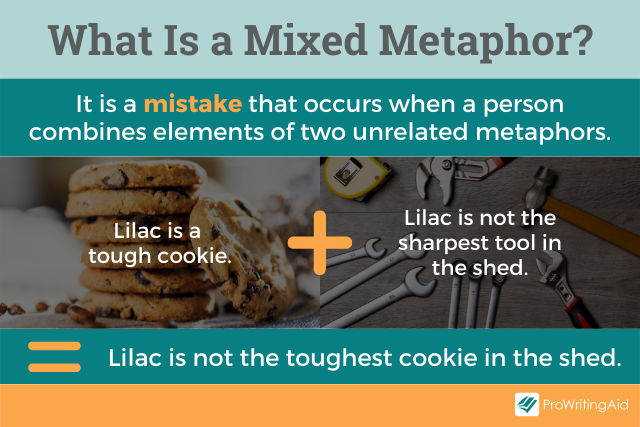
But if you say a person is “not the toughest cookie in the drawer” you’ve just mixed your metaphors, and haven't really said much of anything—other than perhaps you need to “sharpen” yourself!
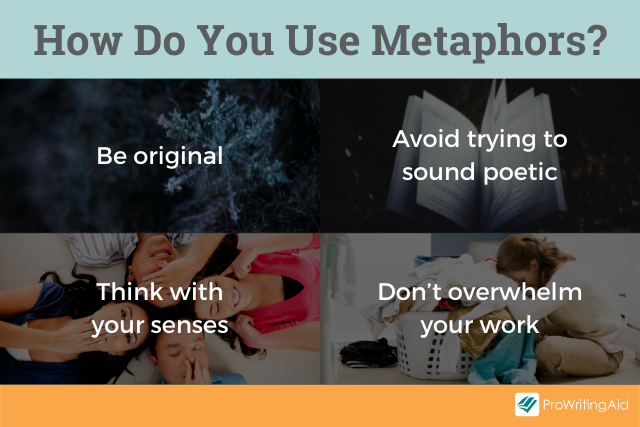
Don’t force metaphors or try too hard to sound “poetic.” Sometimes, the desire to be creative can lead you to produce overdone, overwrought, or overly complex metaphors. Remember, you want the metaphor to enhance the readers’ experience, not leave them frustrated and confused.
Think with your senses. Metaphors can create or deepen your work’s sensory effect. What metaphors can you use to intensify the sights, sounds, smells, tastes, or touch of your work?
Don’t overwhelm your work— especially prose—with metaphors. Metaphors are powerful figures of speech, but that doesn’t mean they should fill every line of your speech or text. Use metaphors thoughtfully and strategically in order to maintain their power and effect.
Be original. Avoid the cliches and stay away from often used images. For example, there are already plenty of love-compared-to-roses and snow-compared-to-blankets metaphors.
You might have to do some brainstorming. The first ideas that come to mind might be obvious because they’re common. Keep thinking. Check out ProWritingAid’s Clichés Report to look for these exhausted figures of speech. Then you can try to freshen them up with a new, creative metaphor!
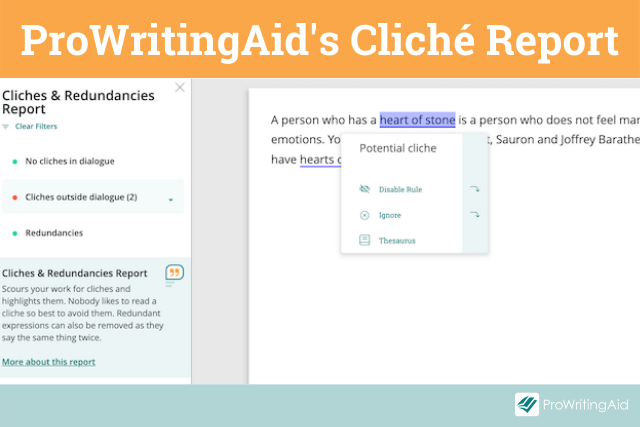
Sign up for a free account and try it for yourself.
Now that we know what a metaphor is, let’s take a closer look at some examples of metaphors at work in the real world.
Metaphor Examples from Literature
“The sun was a toddler insistently refusing to go to bed: It was past eight thirty and still light.”— Fault in Our Stars , John Green
“All the world’s a stage, and all the men and women merely players.”— As You Like It , William Shakespeare
“Her mouth was a fountain of delight.”— The Storm , Kate Chopin
“Life for me ain’t been no crystal stair.”— Mother to Son , Langston Hughes (the entire poem is an example of an extended metaphor)
“I’m a riddle in nine syllables”— Metaphors , Sylvia Plath (each line of the poem is a different metaphor, but the metaphors are all describing one thing.
“But, soft! What light through yonder window breaks? / It is the east, and Juliet is the sun.”— Romeo and Juliet , William Shakespeare
“The frosted wedding cake of the ceiling”— The Great Gatsby , F. Scott Fitzgerald
“Behind him, sitting on piles of scrap and rubble, was the blue kite. My key to Baba’s heart.”— The Kite Runner , Khaled Hosseini
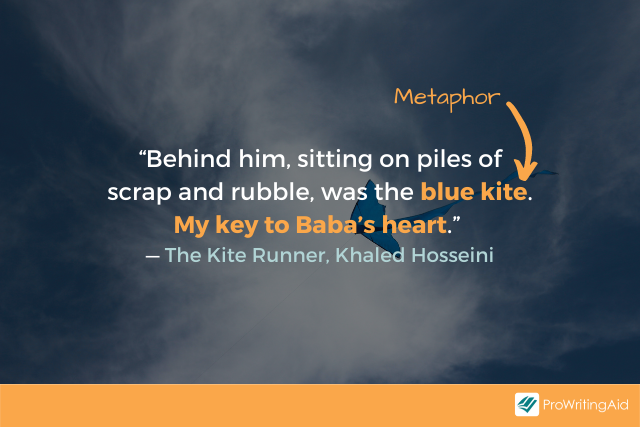
“This blood is a map of the road between us.”— Tear , Linda Hogan
“In her hands, I always became the pawn. I could only run away. And she was the queen, able to move in all directions, relentless in her pursuit, always able to find my weakest spots.”— The Joy Luck Club , Amy Tan
Metaphor Examples from Music
“Life is a highway / I wanna ride it all night long”—Tom Cochrane
“Baby you’re a firework!”—Katy Perry, Ester Dean, Stargate, Sandy Vee
“You are the thunder and I am the lightning”—Selena Gomez, Antonina Armato, Tim James, Devrim Karaoglu
“Love is a temple, Love a higher law”—U2
“You are the sunshine of my life”—Stevie Wonder
Metaphor Examples from Speeches or Famous Quotes
“I assume unhesitatingly the leadership of this great army of our people dedicated to a disciplined attack upon our common problems.”—Franklin D. Roosevelt, First Inaugural Address
"All religions, arts and sciences are branches of the same tree.”—Albert Einstein
“If this virus were a physical assailant, an unexpected and invisible mugger, which I can tell you from personal experience it is, then this is the moment we have begun together to wrestle it to the floor.”— Boris Johson qtd. in the Guardian
“But we refuse to believe that the bank of justice is bankrupt. We refuse to believe that there are insufficient funds in the great vaults of opportunity of this nation.”— Dr. Martin Luther King Jr. , “I Have A Dream”
“What’s that got to do with women’s rights or negroes’ rights? If my cup won’t hold but a pint, and yours holds a quart, wouldn’t you be mean not to let me have my little half measure full?”— Sojourner Truth , “Ain’t I a Woman?”
Metaphor Examples from Advertising
- Budweiser is the “king” of beers
- Chevrolet is the “heartbeat” of America
- Exxon Oil used to tell drivers: “put a tiger in your tank!”
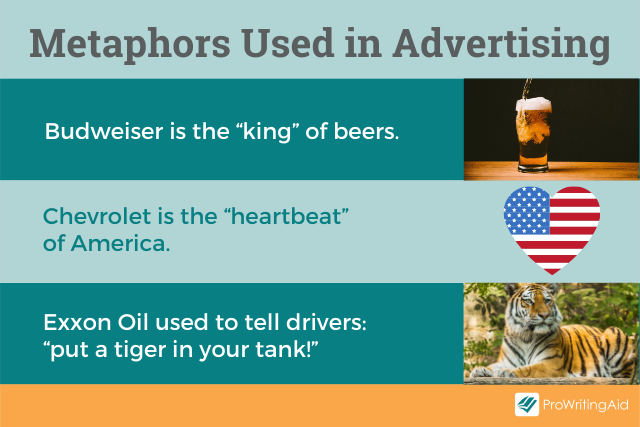
In her article “ The Words that Help Us Understand the World, ” Helene Schumacher says that metaphors “can explain complex concepts we may not be familiar with, help us to connect with each other, and can even shape our thought processes. They help us better understand our world.”
Author James Geary, quoted in the article, says “The only way we have of learning something new is by comparing it to something we already know.”
Metaphors bring to light something we had not perhaps considered or recognized. That something may be a depth of emotion, an insight. Whatever that “something” is, the metaphor delivers it in a unique, stirring way not matched by literal words alone.
Take your writing to the next level:

20 Editing Tips from Professional Writers
Whether you are writing a novel, essay, article, or email, good writing is an essential part of communicating your ideas., this guide contains the 20 most important writing tips and techniques from a wide range of professional writers..

Be confident about grammar
Check every email, essay, or story for grammar mistakes. Fix them before you press send.
Allison Bressmer
Allison Bressmer is a professor of freshman composition and critical reading at a community college and a freelance writer. If she isn’t writing or teaching, you’ll likely find her reading a book or listening to a podcast while happily sipping a semi-sweet iced tea or happy-houring with friends. She lives in New York with her family. Connect at linkedin.com/in/allisonbressmer.
Get started with ProWritingAid
Drop us a line or let's stay in touch via:
200 Short and Sweet Metaphor Examples
Examples of metaphors for love, examples of metaphor from famous people, examples of common metaphors.
| Anger bottled up inside | He was a Lion on the battlefield | Scapegoat |
| A shot across the bows | High and dry | Sea of bees |
| An endless | His eye on the Sparrow | Sea of fire |
| Home was prison | Sea of ghosts | |
| Homework is a breeze | Sea of knowledge | |
| Battle of egos | House of cards | Sea of love |
| Belling the cat | Hungry ghost | Sea of sadness |
| Belt was a | Ideas are water | Sea of smiles |
| Better half | Ideas are wings | Sea of sorrows |
| Ideas in motion | Sea of umbrellas | |
| Blanket of air | Infinite crisis | Sea of uncertainty |
| Blanket of bullets | Infinite spectrum of | Shades of excellence |
| Blanket of clouds | Intimate relationship | Shades of hope |
| Blanket of exemption | Jumping the shark | Shake a leg |
| Blanket of flowers | Know the ropes | Shaking the dust from the feet |
| Blanket of ghosts | Law of the horse | She felt her gorge rising |
| Blanket of hope | Legs were wax | Shipshape and Bristol fashion |
| Blanket of indifference | Life is a journey | Shiver my timbers |
| Blanket of insurance | Life is a mere dream | Shooting the messenger |
| Blanket of love | Light of my life | Shot down an idea |
| Blanket of roses | Loose cannon | Silken lies |
| Blanket of secrecy | Love is a battlefield | Simmer down! |
| Blanket of | Love is a bond | Slippery slope |
| Blanket of stars | Love is a camera, full of memories | Smell of death |
| Blow one’s trumpet | Love is a fine wine | Smell of fear |
| Boiling frog | Love is a garden | Smell of |
| Boiling mad | Love is a growing garland | Smoking gun |
| Broken heart | Love is a journey | Snake oil |
| Butterfly economics | Love is a thrill ride | Social organizations are plants |
| Cabin fever | Love is an experiment | Spherical cow |
| Camel’s nose | Love is an ocean | Stable economy |
| are crossroads | Melting pot | Stable marriage problem |
| Close quarters | compass | Standing on the shoulders of giants |
| Cloudy memory | Necessity is of invention | Sticky wicket |
| Night was falling | Storm of swords | |
| Consumed by love | Night owl | Strength and dignity are her clothing |
| Copper-bottomed | Noisy neighbors | Stubborn stains |
| Cotton candy words | Noisy stomach | Sweet |
| Couch potato | On your beam ends | Sweet smell of success |
| Crop of students | Panic stations | Tell it to the marines |
| Deep dark secret | Path of | |
| Disaster area | Path of glory | The |
| Domino effect | Peace of mind | The evening of one’s life |
| Early bird | Plain sailing | The sea bit my ankles |
| Eyes were fireflies | Point of no return | Their ideas are difficult to swallow |
| Eyes were saucers | Profits fell last year | Thoughts are a storm, unexpected |
| Flogging a dead horse | Puppet government | Three sheets to the wind |
| Food for thought | Push the boat out | Tiger Cub Economies |
| Fork in the road | Rainbow of challenges | Time a thief |
| Full to the gunwales | Rainbow of flavors | Turkeys voting for Christmas |
| Give a wide berth | Rainbow of hope | Walk the plank |
| Go | Rainbow of love | Wave of donations |
| Hand over fist | Wheels of | |
| Hard and fast | Reality an enemy | Work has dried up |
| He got all steamed up | Rug Rats |
Examples of Popular Metaphors
Related posts:, post navigation.
VIDEO COURSE
Finish your draft in our 3-month master class. Sign up now to watch a free lesson!
Learn How to Write a Novel
Finish your draft in our 3-month master class. Enroll now for daily lessons, weekly critique, and live events. Your first lesson is free!

Guides • Perfecting your Craft
Last updated on Feb 14, 2023
10 Types of Creative Writing (with Examples You’ll Love)
About the author.
Reedsy's editorial team is a diverse group of industry experts devoted to helping authors write and publish beautiful books.

About Savannah Cordova
Savannah is a senior editor with Reedsy and a published writer whose work has appeared on Slate, Kirkus, and BookTrib. Her short fiction has appeared in the Owl Canyon Press anthology, "No Bars and a Dead Battery".
About Rebecca van Laer
Rebecca van Laer is a writer, editor, and the author of two books, including the novella How to Adjust to the Dark. Her work has been featured in literary magazines such as AGNI, Breadcrumbs, and TriQuarterly.
A lot falls under the term ‘creative writing’: poetry, short fiction, plays, novels, personal essays, and songs, to name just a few. By virtue of the creativity that characterizes it, creative writing is an extremely versatile art. So instead of defining what creative writing is , it may be easier to understand what it does by looking at examples that demonstrate the sheer range of styles and genres under its vast umbrella.
To that end, we’ve collected a non-exhaustive list of works across multiple formats that have inspired the writers here at Reedsy. With 20 different works to explore, we hope they will inspire you, too.
People have been writing creatively for almost as long as we have been able to hold pens. Just think of long-form epic poems like The Odyssey or, later, the Cantar de Mio Cid — some of the earliest recorded writings of their kind.
Poetry is also a great place to start if you want to dip your own pen into the inkwell of creative writing. It can be as short or long as you want (you don’t have to write an epic of Homeric proportions), encourages you to build your observation skills, and often speaks from a single point of view .
Here are a few examples:
“Ozymandias” by Percy Bysshe Shelley
Nothing beside remains. Round the decay Of that colossal Wreck, boundless and bare The lone and level sands stretch far away.

This classic poem by Romantic poet Percy Shelley (also known as Mary Shelley’s husband) is all about legacy. What do we leave behind? How will we be remembered? The great king Ozymandias built himself a massive statue, proclaiming his might, but the irony is that his statue doesn’t survive the ravages of time. By framing this poem as told to him by a “traveller from an antique land,” Shelley effectively turns this into a story. Along with the careful use of juxtaposition to create irony, this poem accomplishes a lot in just a few lines.
“Trying to Raise the Dead” by Dorianne Laux
A direction. An object. My love, it needs a place to rest. Say anything. I’m listening. I’m ready to believe. Even lies, I don’t care.
Poetry is cherished for its ability to evoke strong emotions from the reader using very few words which is exactly what Dorianne Laux does in “ Trying to Raise the Dead .” With vivid imagery that underscores the painful yearning of the narrator, she transports us to a private nighttime scene as the narrator sneaks away from a party to pray to someone they’ve lost. We ache for their loss and how badly they want their lost loved one to acknowledge them in some way. It’s truly a masterclass on how writing can be used to portray emotions.
If you find yourself inspired to try out some poetry — and maybe even get it published — check out these poetry layouts that can elevate your verse!
Song Lyrics
Poetry’s closely related cousin, song lyrics are another great way to flex your creative writing muscles. You not only have to find the perfect rhyme scheme but also match it to the rhythm of the music. This can be a great challenge for an experienced poet or the musically inclined.
To see how music can add something extra to your poetry, check out these two examples:
“Hallelujah” by Leonard Cohen
You say I took the name in vain I don't even know the name But if I did, well, really, what's it to ya? There's a blaze of light in every word It doesn't matter which you heard The holy or the broken Hallelujah
Metaphors are commonplace in almost every kind of creative writing, but will often take center stage in shorter works like poetry and songs. At the slightest mention, they invite the listener to bring their emotional or cultural experience to the piece, allowing the writer to express more with fewer words while also giving it a deeper meaning. If a whole song is couched in metaphor, you might even be able to find multiple meanings to it, like in Leonard Cohen’s “ Hallelujah .” While Cohen’s Biblical references create a song that, on the surface, seems like it’s about a struggle with religion, the ambiguity of the lyrics has allowed it to be seen as a song about a complicated romantic relationship.
“I Will Follow You into the Dark” by Death Cab for Cutie
If Heaven and Hell decide that they both are satisfied Illuminate the no's on their vacancy signs If there's no one beside you when your soul embarks Then I'll follow you into the dark

You can think of song lyrics as poetry set to music. They manage to do many of the same things their literary counterparts do — including tugging on your heartstrings. Death Cab for Cutie’s incredibly popular indie rock ballad is about the singer’s deep devotion to his lover. While some might find the song a bit too dark and macabre, its melancholy tune and poignant lyrics remind us that love can endure beyond death.
Plays and Screenplays
From the short form of poetry, we move into the world of drama — also known as the play. This form is as old as the poem, stretching back to the works of ancient Greek playwrights like Sophocles, who adapted the myths of their day into dramatic form. The stage play (and the more modern screenplay) gives the words on the page a literal human voice, bringing life to a story and its characters entirely through dialogue.
Interested to see what that looks like? Take a look at these examples:
All My Sons by Arthur Miller
“I know you're no worse than most men but I thought you were better. I never saw you as a man. I saw you as my father.”

Arthur Miller acts as a bridge between the classic and the new, creating 20th century tragedies that take place in living rooms and backyard instead of royal courts, so we had to include his breakout hit on this list. Set in the backyard of an all-American family in the summer of 1946, this tragedy manages to communicate family tensions in an unimaginable scale, building up to an intense climax reminiscent of classical drama.
💡 Read more about Arthur Miller and classical influences in our breakdown of Freytag’s pyramid .
“Everything is Fine” by Michael Schur ( The Good Place )
“Well, then this system sucks. What...one in a million gets to live in paradise and everyone else is tortured for eternity? Come on! I mean, I wasn't freaking Gandhi, but I was okay. I was a medium person. I should get to spend eternity in a medium place! Like Cincinnati. Everyone who wasn't perfect but wasn't terrible should get to spend eternity in Cincinnati.”
A screenplay, especially a TV pilot, is like a mini-play, but with the extra job of convincing an audience that they want to watch a hundred more episodes of the show. Blending moral philosophy with comedy, The Good Place is a fun hang-out show set in the afterlife that asks some big questions about what it means to be good.
It follows Eleanor Shellstrop, an incredibly imperfect woman from Arizona who wakes up in ‘The Good Place’ and realizes that there’s been a cosmic mixup. Determined not to lose her place in paradise, she recruits her “soulmate,” a former ethics professor, to teach her philosophy with the hope that she can learn to be a good person and keep up her charade of being an upstanding citizen. The pilot does a superb job of setting up the stakes, the story, and the characters, while smuggling in deep philosophical ideas.
Personal essays
Our first foray into nonfiction on this list is the personal essay. As its name suggests, these stories are in some way autobiographical — concerned with the author’s life and experiences. But don’t be fooled by the realistic component. These essays can take any shape or form, from comics to diary entries to recipes and anything else you can imagine. Typically zeroing in on a single issue, they allow you to explore your life and prove that the personal can be universal.
Here are a couple of fantastic examples:
“On Selling Your First Novel After 11 Years” by Min Jin Lee (Literary Hub)
There was so much to learn and practice, but I began to see the prose in verse and the verse in prose. Patterns surfaced in poems, stories, and plays. There was music in sentences and paragraphs. I could hear the silences in a sentence. All this schooling was like getting x-ray vision and animal-like hearing.

This deeply honest personal essay by Pachinko author Min Jin Lee is an account of her eleven-year struggle to publish her first novel . Like all good writing, it is intensely focused on personal emotional details. While grounded in the specifics of the author's personal journey, it embodies an experience that is absolutely universal: that of difficulty and adversity met by eventual success.
“A Cyclist on the English Landscape” by Roff Smith (New York Times)
These images, though, aren’t meant to be about me. They’re meant to represent a cyclist on the landscape, anybody — you, perhaps.
Roff Smith’s gorgeous photo essay for the NYT is a testament to the power of creatively combining visuals with text. Here, photographs of Smith atop a bike are far from simply ornamental. They’re integral to the ruminative mood of the essay, as essential as the writing. Though Smith places his work at the crosscurrents of various aesthetic influences (such as the painter Edward Hopper), what stands out the most in this taciturn, thoughtful piece of writing is his use of the second person to address the reader directly. Suddenly, the writer steps out of the body of the essay and makes eye contact with the reader. The reader is now part of the story as a second character, finally entering the picture.
Short Fiction
The short story is the happy medium of fiction writing. These bite-sized narratives can be devoured in a single sitting and still leave you reeling. Sometimes viewed as a stepping stone to novel writing, that couldn’t be further from the truth. Short story writing is an art all its own. The limited length means every word counts and there’s no better way to see that than with these two examples:
“An MFA Story” by Paul Dalla Rosa (Electric Literature)
At Starbucks, I remembered a reading Zhen had given, a reading organized by the program’s faculty. I had not wanted to go but did. In the bar, he read, "I wrote this in a Starbucks in Shanghai. On the bank of the Huangpu." It wasn’t an aside or introduction. It was two lines of the poem. I was in a Starbucks and I wasn’t writing any poems. I wasn’t writing anything.

This short story is a delightfully metafictional tale about the struggles of being a writer in New York. From paying the bills to facing criticism in a writing workshop and envying more productive writers, Paul Dalla Rosa’s story is a clever satire of the tribulations involved in the writing profession, and all the contradictions embodied by systemic creativity (as famously laid out in Mark McGurl’s The Program Era ). What’s more, this story is an excellent example of something that often happens in creative writing: a writer casting light on the private thoughts or moments of doubt we don’t admit to or openly talk about.
“Flowering Walrus” by Scott Skinner (Reedsy)
I tell him they’d been there a month at least, and he looks concerned. He has my tongue on a tissue paper and is gripping its sides with his pointer and thumb. My tongue has never spent much time outside of my mouth, and I imagine it as a walrus basking in the rays of the dental light. My walrus is not well.
A winner of Reedsy’s weekly Prompts writing contest, ‘ Flowering Walrus ’ is a story that balances the trivial and the serious well. In the pauses between its excellent, natural dialogue , the story manages to scatter the fear and sadness of bad medical news, as the protagonist hides his worries from his wife and daughter. Rich in subtext, these silences grow and resonate with the readers.
Want to give short story writing a go? Give our free course a go!

FREE COURSE
How to Craft a Killer Short Story
From pacing to character development, master the elements of short fiction.
Perhaps the thing that first comes to mind when talking about creative writing, novels are a form of fiction that many people know and love but writers sometimes find intimidating. The good news is that novels are nothing but one word put after another, like any other piece of writing, but expanded and put into a flowing narrative. Piece of cake, right?
To get an idea of the format’s breadth of scope, take a look at these two (very different) satirical novels:
Convenience Store Woman by Sayaka Murata
I wished I was back in the convenience store where I was valued as a working member of staff and things weren’t as complicated as this. Once we donned our uniforms, we were all equals regardless of gender, age, or nationality — all simply store workers.

Keiko, a thirty-six-year-old convenience store employee, finds comfort and happiness in the strict, uneventful routine of the shop’s daily operations. A funny, satirical, but simultaneously unnerving examination of the social structures we take for granted, Sayaka Murata’s Convenience Store Woman is deeply original and lingers with the reader long after they’ve put it down.
Erasure by Percival Everett
The hard, gritty truth of the matter is that I hardly ever think about race. Those times when I did think about it a lot I did so because of my guilt for not thinking about it.
Erasure is a truly accomplished satire of the publishing industry’s tendency to essentialize African American authors and their writing. Everett’s protagonist is a writer whose work doesn’t fit with what publishers expect from him — work that describes the “African American experience” — so he writes a parody novel about life in the ghetto. The publishers go crazy for it and, to the protagonist’s horror, it becomes the next big thing. This sophisticated novel is both ironic and tender, leaving its readers with much food for thought.
Creative Nonfiction
Creative nonfiction is pretty broad: it applies to anything that does not claim to be fictional (although the rise of autofiction has definitely blurred the boundaries between fiction and nonfiction). It encompasses everything from personal essays and memoirs to humor writing, and they range in length from blog posts to full-length books. The defining characteristic of this massive genre is that it takes the world or the author’s experience and turns it into a narrative that a reader can follow along with.
Here, we want to focus on novel-length works that dig deep into their respective topics. While very different, these two examples truly show the breadth and depth of possibility of creative nonfiction:
Men We Reaped by Jesmyn Ward
Men’s bodies litter my family history. The pain of the women they left behind pulls them from the beyond, makes them appear as ghosts. In death, they transcend the circumstances of this place that I love and hate all at once and become supernatural.
Writer Jesmyn Ward recounts the deaths of five men from her rural Mississippi community in as many years. In her award-winning memoir , she delves into the lives of the friends and family she lost and tries to find some sense among the tragedy. Working backwards across five years, she questions why this had to happen over and over again, and slowly unveils the long history of racism and poverty that rules rural Black communities. Moving and emotionally raw, Men We Reaped is an indictment of a cruel system and the story of a woman's grief and rage as she tries to navigate it.
Cork Dork by Bianca Bosker
He believed that wine could reshape someone’s life. That’s why he preferred buying bottles to splurging on sweaters. Sweaters were things. Bottles of wine, said Morgan, “are ways that my humanity will be changed.”
In this work of immersive journalism , Bianca Bosker leaves behind her life as a tech journalist to explore the world of wine. Becoming a “cork dork” takes her everywhere from New York’s most refined restaurants to science labs while she learns what it takes to be a sommelier and a true wine obsessive. This funny and entertaining trip through the past and present of wine-making and tasting is sure to leave you better informed and wishing you, too, could leave your life behind for one devoted to wine.
Illustrated Narratives (Comics, graphic novels)
Once relegated to the “funny pages”, the past forty years of comics history have proven it to be a serious medium. Comics have transformed from the early days of Jack Kirby’s superheroes into a medium where almost every genre is represented. Humorous one-shots in the Sunday papers stand alongside illustrated memoirs, horror, fantasy, and just about anything else you can imagine. This type of visual storytelling lets the writer and artist get creative with perspective, tone, and so much more. For two very different, though equally entertaining, examples, check these out:
Calvin & Hobbes by Bill Watterson
"Life is like topography, Hobbes. There are summits of happiness and success, flat stretches of boring routine and valleys of frustration and failure."

This beloved comic strip follows Calvin, a rambunctious six-year-old boy, and his stuffed tiger/imaginary friend, Hobbes. They get into all kinds of hijinks at school and at home, and muse on the world in the way only a six-year-old and an anthropomorphic tiger can. As laugh-out-loud funny as it is, Calvin & Hobbes ’ popularity persists as much for its whimsy as its use of humor to comment on life, childhood, adulthood, and everything in between.
From Hell by Alan Moore and Eddie Campbell
"I shall tell you where we are. We're in the most extreme and utter region of the human mind. A dim, subconscious underworld. A radiant abyss where men meet themselves. Hell, Netley. We're in Hell."
Comics aren't just the realm of superheroes and one-joke strips, as Alan Moore proves in this serialized graphic novel released between 1989 and 1998. A meticulously researched alternative history of Victorian London’s Ripper killings, this macabre story pulls no punches. Fact and fiction blend into a world where the Royal Family is involved in a dark conspiracy and Freemasons lurk on the sidelines. It’s a surreal mad-cap adventure that’s unsettling in the best way possible.
Video Games and RPGs
Probably the least expected entry on this list, we thought that video games and RPGs also deserved a mention — and some well-earned recognition for the intricate storytelling that goes into creating them.
Essentially gamified adventure stories, without attention to plot, characters, and a narrative arc, these games would lose a lot of their charm, so let’s look at two examples where the creative writing really shines through:
80 Days by inkle studios
"It was a triumph of invention over nature, and will almost certainly disappear into the dust once more in the next fifty years."

Named Time Magazine ’s game of the year in 2014, this narrative adventure is based on Around the World in 80 Days by Jules Verne. The player is cast as the novel’s narrator, Passpartout, and tasked with circumnavigating the globe in service of their employer, Phileas Fogg. Set in an alternate steampunk Victorian era, the game uses its globe-trotting to comment on the colonialist fantasies inherent in the original novel and its time period. On a storytelling level, the choose-your-own-adventure style means no two players’ journeys will be the same. This innovative approach to a classic novel shows the potential of video games as a storytelling medium, truly making the player part of the story.
What Remains of Edith Finch by Giant Sparrow
"If we lived forever, maybe we'd have time to understand things. But as it is, I think the best we can do is try to open our eyes, and appreciate how strange and brief all of this is."
This video game casts the player as 17-year-old Edith Finch. Returning to her family’s home on an island in the Pacific northwest, Edith explores the vast house and tries to figure out why she’s the only one of her family left alive. The story of each family member is revealed as you make your way through the house, slowly unpacking the tragic fate of the Finches. Eerie and immersive, this first-person exploration game uses the medium to tell a series of truly unique tales.
Fun and breezy on the surface, humor is often recognized as one of the trickiest forms of creative writing. After all, while you can see the artistic value in a piece of prose that you don’t necessarily enjoy, if a joke isn’t funny, you could say that it’s objectively failed.
With that said, it’s far from an impossible task, and many have succeeded in bringing smiles to their readers’ faces through their writing. Here are two examples:
‘How You Hope Your Extended Family Will React When You Explain Your Job to Them’ by Mike Lacher (McSweeney’s Internet Tendency)
“Is it true you don’t have desks?” your grandmother will ask. You will nod again and crack open a can of Country Time Lemonade. “My stars,” she will say, “it must be so wonderful to not have a traditional office and instead share a bistro-esque coworking space.”

Satire and parody make up a whole subgenre of creative writing, and websites like McSweeney’s Internet Tendency and The Onion consistently hit the mark with their parodies of magazine publishing and news media. This particular example finds humor in the divide between traditional family expectations and contemporary, ‘trendy’ work cultures. Playing on the inherent silliness of today’s tech-forward middle-class jobs, this witty piece imagines a scenario where the writer’s family fully understands what they do — and are enthralled to hear more. “‘Now is it true,’ your uncle will whisper, ‘that you’ve got a potential investment from one of the founders of I Can Haz Cheezburger?’”
‘Not a Foodie’ by Hilary Fitzgerald Campbell (Electric Literature)
I’m not a foodie, I never have been, and I know, in my heart, I never will be.
Highlighting what she sees as an unbearable social obsession with food , in this comic Hilary Fitzgerald Campbell takes a hilarious stand against the importance of food. From the writer’s courageous thesis (“I think there are more exciting things to talk about, and focus on in life, than what’s for dinner”) to the amusing appearance of family members and the narrator’s partner, ‘Not a Foodie’ demonstrates that even a seemingly mundane pet peeve can be approached creatively — and even reveal something profound about life.
We hope this list inspires you with your own writing. If there’s one thing you take away from this post, let it be that there is no limit to what you can write about or how you can write about it.
In the next part of this guide, we'll drill down into the fascinating world of creative nonfiction.
Join a community of over 1 million authors
Reedsy is more than just a blog. Become a member today to discover how we can help you publish a beautiful book.

We made a writing app for you
Yes, you! Write. Format. Export for ebook and print. 100% free, always.

1 million authors trust the professionals on Reedsy. Come meet them.
Enter your email or get started with a social account:
Metaphor Examples for Writers
Francesco Carta fotografo / Getty Images
- Fiction Writing Careers
- Technology Careers
- Sports Careers
- Project Management
- Professional Writer
- Music Careers
- Legal Careers
- US Military Careers
- Government Careers
- Finance Careers
- Entertainment Careers
- Criminology Careers
- Book Publishing
- Animal Careers
- Advertising
A metaphor is a literary device writers use to make their writing more evocative. Without going into wordy explanations, a writer can use the figurative language of a metaphor for illustrative purposes or to highlight the similarities between two different ideas, activities, or objects.
A metaphor is made up of two parts, a tenor, which is the subject of the metaphor, and the vehicle, which is the thing that illustrates the metaphor. There are more than a dozen different kinds of metaphors, including absolute, complex, conceptual, conventional, creative, dead, extended, mixed, primary, root, simile, submerged, therapeutic, and visual, that are used in writing to illustrate or symbolize something else.
An example of one of the more expressive metaphors in literature comes from American fiction writer F. Scott Fitzgerald, who once wrote, "All good writing is swimming underwater and holding your breath." A complex metaphor like this works because it is sensory. Most people know what it feels like to swim underwater while they hold their breath. Even if they are not writers, the metaphor he uses gives a sense of what the process feels like.
Metaphors often get confused with similes. Whereas a metaphor makes a declarative statement that one thing is another thing, a simile uses words “like” or “as” to compare two similar things. The difference is subtle but distinct. For example, if Fitzgerald had written that "good writing is like swimming underwater," it would be a simile. The other part that can get confusing is that a simile is a type of metaphor, but a metaphor is not always a simile.
Metaphors in Literature and Popular Culture
Perhaps one of the most commonly cited examples of a metaphor in English literature is Shakespeare's "All the world's a stage" monologue from "As You Like It":
"All the world's a stage, And all the men and women merely players; They have their exits and their entrances..."
One reason this metaphor is effective is that each line contains a separate metaphor, but all come together as part of a single, broader idea—that life itself is like a stage play. Some other examples of metaphors in literature and popular culture include:
- "You are the sunshine of my life...And if I thought our love was ending, I'd find myself drowning in my own tears." -Stevie Wonder
- "I finally asked you to dance on the last slow song, beneath the moon that was really a disco ball." -Lady Antebellum
- "The sky was a purple bruise, the ground was iron, and you fell all around the town until you looked the same." -Elvis Costello
- "You ain't nothing but a hound dog." -Made famous by Elvis Presley, but written by Jerry Leiber and Mike Stoller
- “A hospital bed is a parked taxi with the meter running." -Groucho Marx
- “Dying is a wild night and a new road.” -Emily Dickinson
- “Time rises and rises, and when it reaches the level of your eyes you drown.” -Margaret Atwood
- “I’m a little pencil in the hand of a writing God.” -Mother Teresa
- “Books are the mirrors of the soul.” -Virginia Woolf
Each of these metaphors works in different ways, but they all force the reader to think about what they mean. Once the reader is able to make a connection to the metaphor, the meaning becomes very clear. Take that last line, for instance. Imagining a mirror that can look into your soul evokes a powerful image of the impact books can have.
Mixed and Extended Metaphors
Like most literary devices, metaphors can be ineffective when misused. They end up either confusing the reader or drawing attention to the author's lack of skill. A mixed metaphor moves from one reference to a second, unrelated, or inconsistent thing.
For example, in the statement "Our keyboard will teach your mind's eye to play by ear," the speaker has mixed two metaphors, leading to nonsense.
However, there are some instances when mixed metaphors work despite themselves somehow. In his song "Little Red Corvette," Prince, a songwriter known for his sexually-charged lyrics, compares the proclivities of a paramour to a fast car and mixes in a metaphor about the use of contraceptives.
"I guess I should've known by the way you parked your car sideways, that it wouldn't last," he sings, before mixing in another metaphor with the line, "See, you're the kinda person that believes in makin' out once—love 'em and leave 'em fast. I guess I must be dumb 'cuz you had a pocket full of horses, Trojan and some of them used."
The latter part of that verse is a mixed metaphor that then becomes an extended metaphor later in the song when Prince references his paramour's past lovers. "I guess I should've closed my eyes when you drove me to the place where your horses run free. 'Cause I felt a little ill when I saw all the pictures of the jockeys that were there before me."
Cliched Metaphors to Avoid
As you can see, you don't have to look very far to find examples of metaphors. We hear and use various common expressions and cliches every day that are metaphors:
- It's raining cats and dogs.
- I'm visiting an old flame.
- He's a loose cannon.
- She found herself behind the eight ball.
- He drives me up a wall.
- She saw the light at the end of the tunnel.
Although these are all are good examples of what metaphors are and how they can effectively express thoughts or ideas, they represent the sort of cliches—or dead metaphors—that should be avoided in writing. Metaphors are most effective when they are original and help readers envision complex feelings or actions in ways they never have.
- Symbolism in Fiction Writing
- How to Use Everyday Metaphors and Similes
- How to Use Metaphors Correctly and Avoid Cliches
- Types of Figurative Language That Enhance Your Writing
- Ways to Use Figurative Language in Writing
- Writing Characters in Fiction
- What Is Second-Person Point of View?
- Alliteration Examples in Fiction
- What Is a Theme in Literature?
- What Voice Means in Writing
- Third-Person Point of View: Omniscient or Limited
- Learn About First-Person Point of View in Fiction
- What Is Style?
- Better Ways to Describe Action in Writing
- Story Point of View
- How to Recognize and Create an Unreliable Narrator
- Literary Terms
When & How to Write a Metaphor
- Definition & Examples
- When & How to Write a Metaphor
How to Write a Metaphor
A. avoid clichés.
Very often, you’ll write metaphors without realizing it. Since certain metaphors are very common, many of them have become clichéd , or overused.
Normal Sentence:
My day was emotionally jolting.
With Cliché Metaphor:
My day was an emotional roller-coaster .
Here and there, clichés are harmless, but they can start to add up and become repetitive and unoriginal if you use too many of them. Don’t worry about this as long as you use the clichés sparingly.
Here are a few more examples of metaphors that have become clichés:
- Ticking time bomb
- Tip of the iceberg
- Slippery slope
- Going the extra mile
- Icy personality
- Turning in one’s grave
- About to explode (from anger)
B. Tips on Forming Creative Metaphors
The real trick, though, is to write original metaphors that really stick in the reader’s mind, and there’s no hard-and-fast rule for accomplishing this. It takes a lot of creativity to write a good metaphor!
One way to practice is to start with the phrase “life is…and I am…” By starting with one metaphor (for life) and extending it to yourself, you can practice thinking systematically about the meanings of your metaphors, while at the same time working on your creative skills.
Life is a canvas, and I am a painter.
Life is a canvas, and I am the paint.
Life is an hourglass, and I am a single grain of sand.
Life is an hourglass, and I am about to turn it over once more.
Life is a classroom, and I am sitting in the front row.
Life is a classroom, and I am sitting in the back row.
Notice how different these statements are, and how different they all are from a cliché.
C. Avoid mixed metaphors
This is an important point for using metaphors in your writing – once you’ve decided on a metaphor, you have to see it through for it to have the strongest effect. Don’t just forget about it and pick up a new metaphor immediately! Too many different metaphors in your writing can make it confusing or too over the top.
A mixed metaphor combines one or more metaphors in a sentence in a way that doesn’t really make sense. For example, imagine if you tried to encourage your staff to excel with a project by saying “let’s get back out on the court and hit this one out of the park!” You’d be combining a basketball metaphor with a baseball metaphor—really, you should say “let’s get back out on the field and hit this one out of the park!”
Here’s an example of a triple mixed metaphor:
Mr. Speaker, I smell a rat. I see him floating in the air. But mark me, sir, I will nip him in the bud. ( Garner’s Modern American Usage , Bryan A. Garner)
First, we have the common metaphor “I smell a rat,” to describe a person committing a betrayal. But then Garner uses an unrelated metaphor to describe him as “floating,” finally concluding with a metaphor that refers to plants.
When to Use Metaphor
Strictly speaking, metaphors should be used only in creative writing since they rely on figurative language (not literal meaning) and are therefore untrue statements. Metaphors are also often vague and may sound too colloquial for formal work. Sometimes a subtle metaphor will slip into formal work(especially in the form of common phrases and clichés). This is OK now and then, but it’s best to avoid it if possible.
For example, if you were writing a paper on Abraham Lincoln, it would sound pretty strange to say he had a “heart of gold.” First of all, it’s a cliché. Second, it’s not literally true. And third, it doesn’t really tell you much about Lincoln. So, it’s better to say something more specific and concrete, like “For Lincoln, compassion was one of the most important moral virtues.”
There is a rhetorical device though (that people often confuse with metaphor), that you’ll see in formal writing all the time. This is simile . Similes explicitly state that two things are alike, rather than simply equating them as a metaphor does. This can be a very useful way to explain complex ideas:
With Simile:
“The magnetosphere works like a big tinted window, protecting the earth from the sun’s harmful rays while still letting some light and heat pass through.”
With Metaphor:
“The magnetosphere is a big tinted window…”
Using metaphor, in this case, makes the sentence untrue. But the simile is a helpful tool for clarifying the writer’s point.
None of this, of course, applies to creative writing. In creative writing, metaphors are extremely effective – as long as you don’t mix them!
List of Terms
- Alliteration
- Amplification
- Anachronism
- Anthropomorphism
- Antonomasia
- APA Citation
- Aposiopesis
- Autobiography
- Bildungsroman
- Characterization
- Circumlocution
- Cliffhanger
- Comic Relief
- Connotation
- Deus ex machina
- Deuteragonist
- Doppelganger
- Double Entendre
- Dramatic irony
- Equivocation
- Extended Metaphor
- Figures of Speech
- Flash-forward
- Foreshadowing
- Intertextuality
- Juxtaposition
- Literary Device
- Malapropism
- Onomatopoeia
- Parallelism
- Pathetic Fallacy
- Personification
- Point of View
- Polysyndeton
- Protagonist
- Red Herring
- Rhetorical Device
- Rhetorical Question
- Science Fiction
- Self-Fulfilling Prophecy
- Synesthesia
- Turning Point
- Understatement
- Urban Legend
- Verisimilitude
- Essay Guide
- Cite This Website
Writer's Bounty
Providing Support for Writers and Teachers of Writing
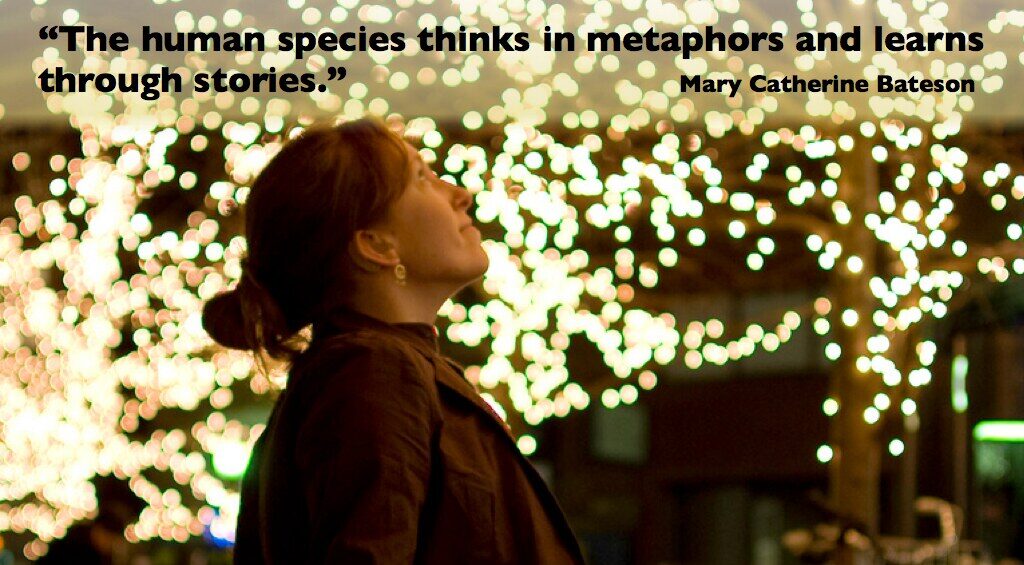
Teaching Metaphors: Crafting Powerful Literary Devices
Welcome to our guide on teaching metaphor to student writers! Writers often seek to enhance their language and create a powerful impact on their readers. One way to achieve this is through the use of literary devices such as metaphors. In this article, we will delve into the definition of a metaphor, examples of how they can be used in writing, techniques for crafting powerful metaphors, as well as easy activities to add to your teacher toolbox.
What is a Metaphor?
A metaphor is a figure of speech that compares two things that are not alike in order to suggest a similarity or analogy between them. Unlike similes, which use “like” or “as” to make a comparison, metaphors make a direct comparison between the two objects. For example, “Life is a journey” is a metaphor that compares the experience of living to the act of traveling on a path or road.

The Impact of Metaphors in Writing
Metaphors can have a significant impact on the reader. They can help to create vivid and memorable images in the reader’s mind, making the writing more engaging and interesting. Additionally, metaphors can add depth and complexity to the text, as they allow the writer to explore complex ideas and emotions in a more accessible way.
Examples of Metaphors in Literature
Metaphors are commonly used in literature to create vivid and memorable images. Here are some examples:
- “All the world’s a stage, and all the men and women merely players.” – William Shakespeare, As You Like It
- “Her voice was music to his ears.” – unknown
- “The sun is a golden coin in the sky.” – unknown
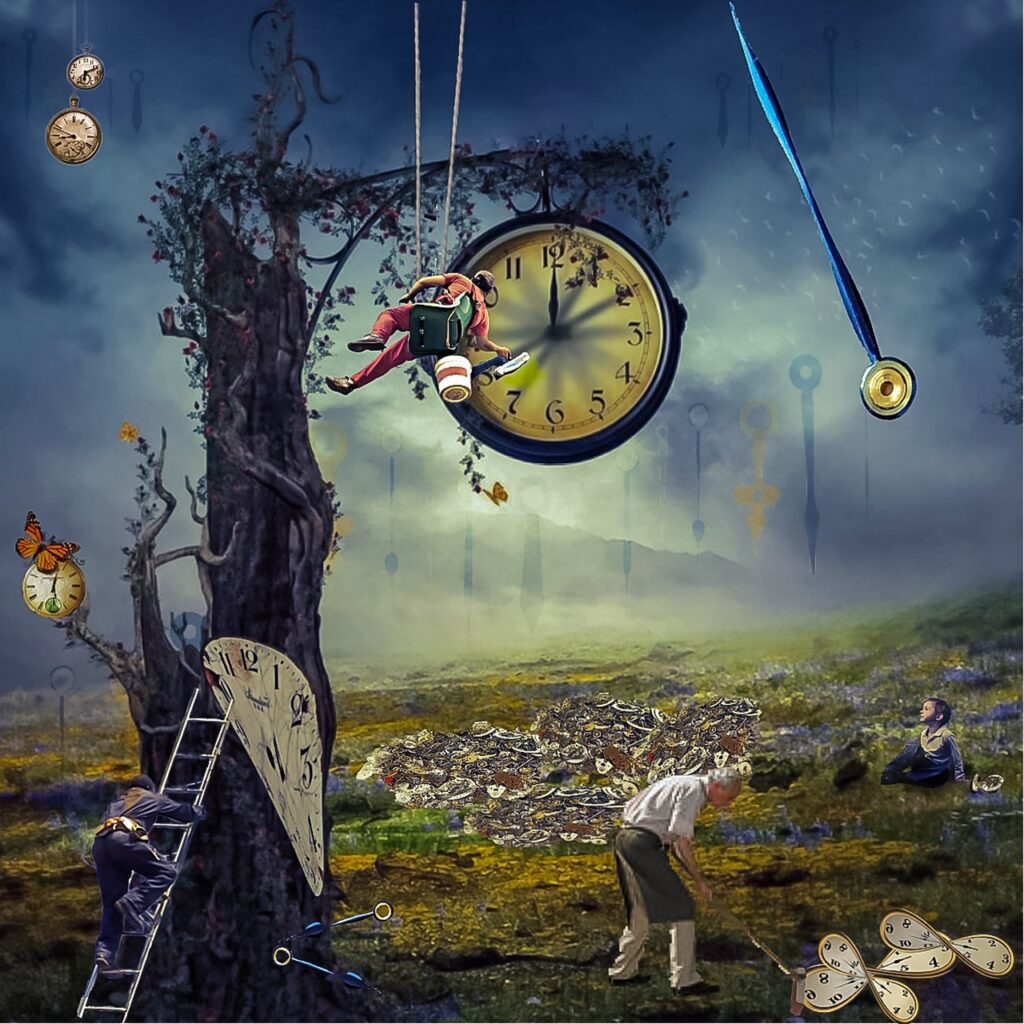
Techniques for Crafting Powerful Metaphors
Crafting powerful metaphors can be a challenging task, but there are some techniques that writers can use to make their metaphors more effective:
- Use Concrete Language: The more concrete and specific the language you use, the more powerful your metaphor will be. For example, instead of saying “He was angry,” you could say “His face turned red like a boiling kettle.”
- Choose the Right Comparison: To make a metaphor work, you need to choose the right comparison. Think carefully about the two objects you are comparing and try to find a connection that will resonate with your reader.
- Avoid Clichés: While it can be tempting to use a familiar metaphor, such as “The apple doesn’t fall far from the tree,” these types of clichés can make your writing feel tired and unoriginal. Instead, try to come up with a fresh and unique comparison.
Quick and Easy Teaching Metaphor Activities
- Metaphor Scavenger Hunt: Provide students with a list of metaphors and have them find examples of each in books, movies, or TV shows. This will help students practice identifying metaphors in context.
- Metaphor Mad Libs: Create a story template with blanks for metaphors. Students can then fill in the blanks with their own metaphors, creating a silly and fun story.
- Metaphor Match-Up: Provide students with a list of nouns and a list of adjectives. Have them match the two lists to create a metaphor. For example, “The sun is a blazing fire.”
- Metaphor Drawing: Give students a simple prompt, such as “Life is a rollercoaster,” and have them draw a picture that represents the metaphor. This will help students visualize the comparison and develop a deeper understanding of metaphors.
- Metaphor Swap: Have students work in pairs to create a metaphor. Then, have them switch metaphors with another pair and try to come up with a new comparison based on the other pair’s metaphor. This will help students practice thinking creatively and outside of the box.
By incorporating these activities into your lesson plans, you can help students develop a deeper understanding and appreciation for the power of metaphors in writing.

Final Thoughts on Teaching Metaphors
Metaphors are a powerful tool in the writer’s toolbox, and can help to create memorable and engaging writing. By using concrete language, choosing the right comparison, and avoiding clichés, writers can craft metaphors that have a lasting impact on their readers. Teaching metaphors to your students helps them to become compelling writers.
Similar Posts
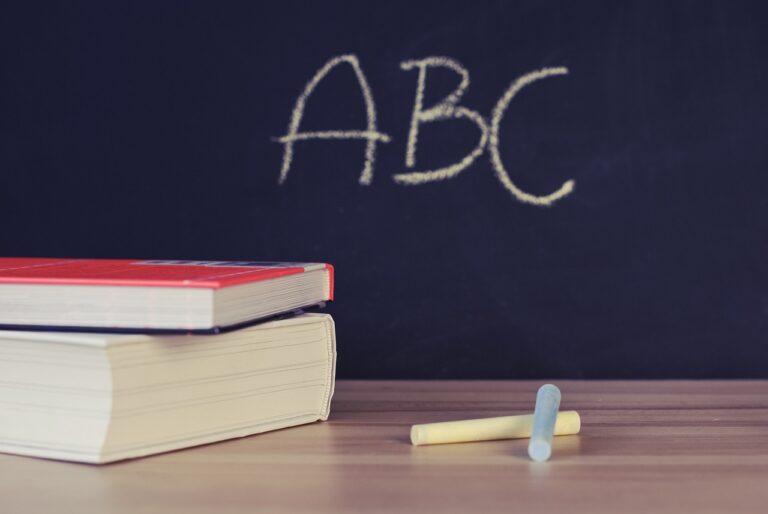
The ABCs of Teaching Creative Writing
Teaching creative writing can be tough, especially for a new teacher. It’s hard to know how to help each student because everyone is different. It’s also hard for some students to use their imagination and be original. As a new teacher, it can be especially hard to figure out how to teach in a way…

Teaching Story Elements: Lesson Plans Made Easy
Hello there, teachers! In this guide, we’ll be discussing how to create a lesson plan for teaching the elements of a story. By the end of this article, you’ll have a clear understanding of how to create an engaging and effective lesson plan that your students will love. Step 1: Determine Your Learning Objectives Your…

The Write Game: Level Up Student Creativity with Fun and Play
Hey there, fellow word nerds and educators! Welcome to “The Write Game,” where I’m about leveling student creativity through fun and play. If you’ve ever felt like your students were stuck in a creative rut or struggled to engage them in the writing process, you’ve come to the right place. I’m here to help you…

Mastering ESL Creative Writing in a Multilingual Classroom
Diving headfirst into teaching creative writing for ESL students can feel like navigating through uncharted waters. But guess what? You’re not alone. We’ve been there, and we’ve got the compass to guide you through. The Multilingual Classroom: Challenges and Opportunities Sure, teaching in a multilingual classroom comes with its fair share of challenges. There’s the…

Teaching Creative Writing: Top 10 Reasons It is Essential
Teaching creative writing is important! As a teacher, there are many times when students or parents asked me “Why are we doing this?” It makes my heart sink because it feels like they didn’t believe in their abilities. The problem gets worse when the person asking has potential as a writer. They don’t understand what…
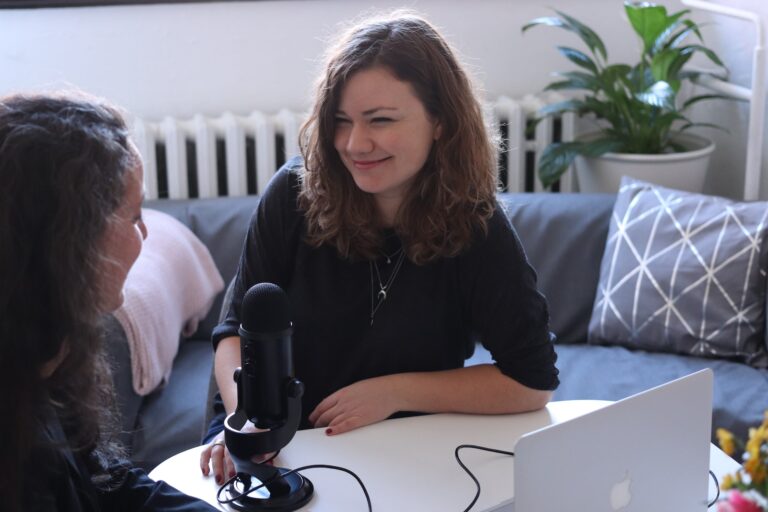
Student Writers Unleashed: Character Interviews 101
Character interviews are an essential tool for teachers who strive to empower their student writers in creating authentic, relatable, and engaging characters. By introducing the concept of character interviews in the classroom, you enable students to delve deep into the psyche of their characters, understanding their motivations, desires, fears, and idiosyncrasies. With your guidance, your…
11 Best Extended Metaphor Examples: Write One Today
These examples of extended metaphors from song lyrics, poems, books, and plays will help you understand this literary device better.
A metaphor is a literary device that compares two, unlike things or concepts. Unlike similes, metaphors do not use the word “like” or “as” but rather compare the items using imagery and with a less direct comparison. Simple metaphors take just a sentence or two to make the comparison.
The purpose of a metaphor is to make it easier for readers to understand a key idea. They can also dramatically improve the readability of a piece of writing. All types of writers from authors to poets to playwrights use metaphors in their works to varying degrees. Some even create entire works around a single extended metaphor.
What Is An Extended Metaphor?
How do i write an extended metaphor, 1. “hope is the thing with feathers” by emily dickinson, 2. “the road not taken” by robert frost, 3. “mother to son” by langston hughes, 4. romeo and juliet by william shakespeare, 5. as you like it by william shakespeare, 6. the great gatsby by f. scott fitzgerald, 7. seize the night by dean koontz, 8. “i have a dream” speech by martin luther king, jr., 9. havard university commencement address by will ferrell, 10. “firework” by katy perry, 11. “o captain my captain” by walt whitman.
When an entire poem or literary work, (or large portions), is a metaphor, it is known as an extended metaphor. This type of figurative language can be engaging for the reader, drawing them in and helping them better understand the meaning of the work. Extended metaphors can have several purposes. Sometimes, the purpose is to get the reader to think about the characteristics of something by comparing it to something entirely different. Sometimes the purpose is to create a humorous connection. However, the end goal almost always is to create an emotional connection with the reader.
Using a metaphor in your fiction, non-fiction and poetry is relatively easy. First, consider an idea you want to communicate to readers. Next, pick a seemingly unrelated ordinary object. Ideally, it’s something visual or everyday so readers can relate to it. Now, write down a list of what makes the idea and object distinct from each other. Next, write a second list of anything they may have in common. Write several sentences that link the concept and object.
You may need to contrast between them or hypothesize a relationship. Be creative. Finally, pick the extended metaphor that communicates your intention best. From poems to plays to short stories , here are some of the best examples of extended metaphors from classic and modern literature and music.

In this poem , Dickinson compares hope to a little bird. She claims that it never stops singing to the soul, even when all seems full of despair. Because of the beautiful picture painted in the lines of verse, this poem is an example of an extended metaphor. Like many metaphor poems , it helps the reader truly understand her meaning, even when, in the end, she says hope never “asked a crumb of me.”
“Hope is the thing with feathers That perches in the soul, And sings the tune – without words, And never stops at all, And the sweetest in the gale is heard;”
In this famous poem by Robert Frost, the speaker stands on the edge of a choice between two roads. While the poem appears to be about the speaker’s travels, in reality, he is talking about life choices, making it an extended metaphor. The fork in the road, the poem’s central image, is a pivotal decision faced in life, and the end of the poem discusses how influential one decision can be. You might also find these examples of tragic flaw in literature interesting.
“Two roads diverged in a yellow wood, And sorry I could not travel both And be one traveler, long I stood And looked down one as far as I could To where it bent in the undergrowth;”
In “Mother to Son,” Hughes compares life to a crystal stair, indicating that its struggles are much more complex than climbing a crystal staircase. Instead, the struggles of life are like broken boards and splinters on an old, rugged wooden staircase.
“Well, son, I’ll tell you: Life for me ain’t been no crystal stair. It’s had tacks in it, And splinters, And boards torn up, And places with no carpet on the floor – Bare. But all the time“
In the famous balcony scene in Shakespeare’s most iconic play , the playwright uses a metaphor to compare Juliet to the sun. Because the single metaphor continues for many lines through the monologue, it fits the definition of the extended metaphor.
“But, soft! what light through yonder window breaks? It is the east, and Juliet is the sun. Arise, fair sun, and kill the envious moon, Who is already sick and pale with grief, That thou her maid art far more fair than she:”
Shakespeare also uses a sustained metaphor in his play As You Like It. In Act II, Scene VII, his character Jaques launches into a monologue. It contains a metaphor comparing the world to a stage with actors upon it . The metaphor continues for many lines, so it fits the extended metaphor definition.
“All the world’s a stage, And all the men and women merely players; They have their exits and their entrances; And one man in his time plays many parts, His acts being seven ages. At first the infant, Mewling and puking in the nurse’s arms;”
In one particular passage of The Great Gatsby , Fitzgerald draws a parallel between the poor and ashes. Both are plentiful, and both grow into ridges and hills. Nevertheless, it paints a bleak picture of life for someone without income.
“This is a valley of ashes – a fantastic farm where ashes grow like wheat into ridges and hills and grotesque gardens; where ashes take the forms of houses and chimneys and rising smoke and, finally, with a transcendent effort, of ash-grey men, who move dimly and already crumbling through the powdery air.”
In one part of Seize the Night , the narrator indicates his mind and imagination are like a 300-ring circus. However, he decides to stop and get a snack at ring 299. To keep the metaphor going, the snack is popcorn and soda, which you could easily find in a circus. If you like this example, check out our list of the best Dean Koontz books.
“Bobby Holloway says my imagination is a three-hundred-ring circus. Currently, I was in ring two hundred and ninety-nine, with elephants dancing and clowns cart wheeling and tigers leaping through rings of fire. The time had come to step back, leave the main tent, go buy some popcorn and a Coke, bliss out, cool down.”
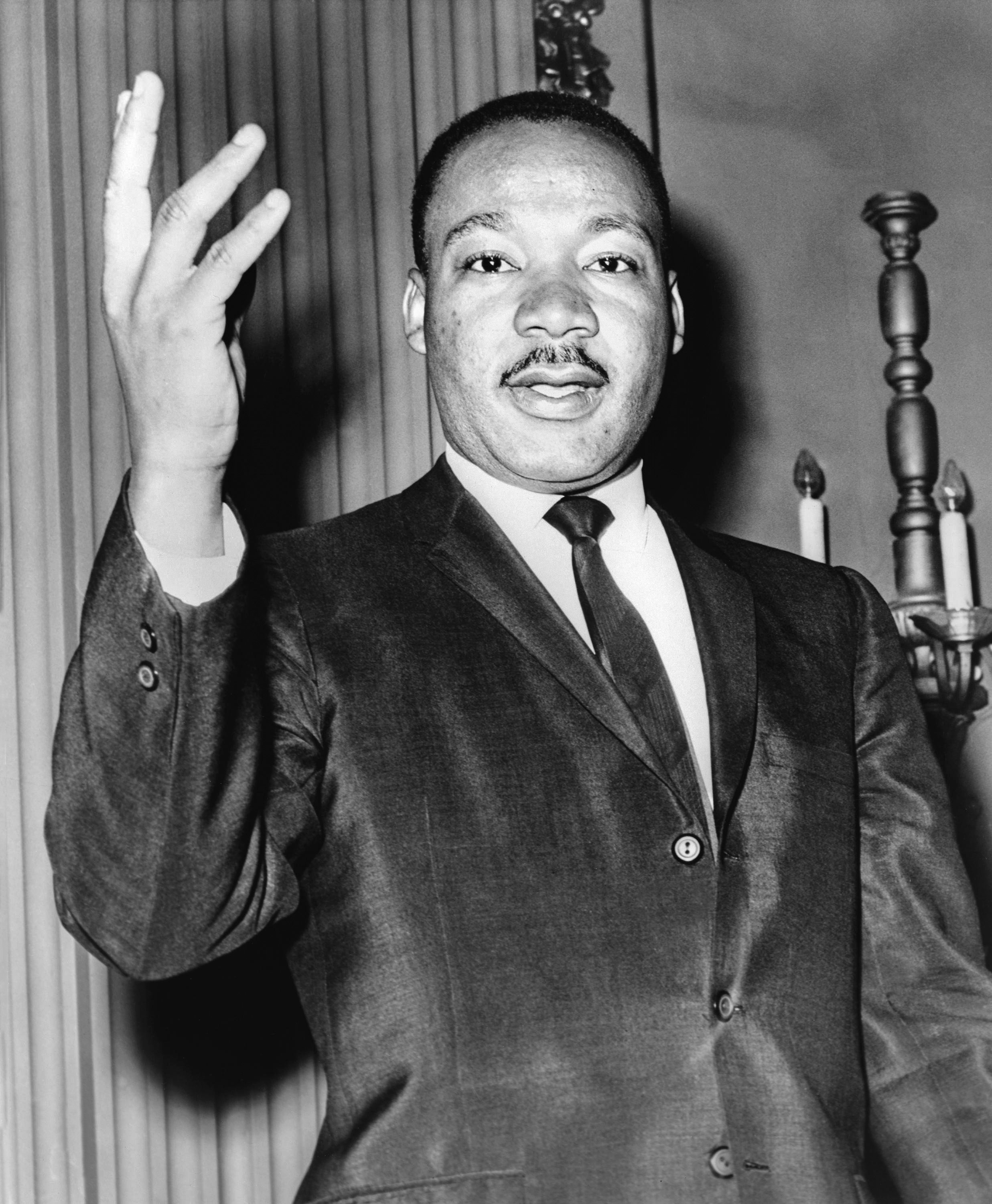
In his “ I Have a Dream” speech, King compares the nation’s Constitution to a promissory note, and then alludes to the fact that prejudice means white people had failed to deliver on that debt. He continues the metaphor by talking about the “bankruptcy” of justice and the “insufficient funds” received by the black people of America.
“When the architects of our republic wrote the magnificent words of the Constitution and the Declaration of Independence, they were signing a promissory note to which every American was to fall heir. This note was a promise that all men, yes, black men as well as white men, would be guaranteed the “unalienable Rights” of “Life, Liberty and the pursuit of Happiness.”
When asked to speak to the graduating class of Harvard in 2003, comedian Will Ferrell used an extended metaphor to discuss his lack of education. Instead of commenting directly on this shortcoming, he compared his life’s knowledge to a university in his famous speech . Thankfully, he does not intend for the hearer to take his metaphor too seriously. For more examples like this, check out our list of metaphor examples for kids .
“I graduated from the University of Life. All right? I received a degree from the School of Hard Knocks. And our colors were black and blue, baby.”
Song lyrics often contain extended metaphors, which is clearly seen in Katy Perry’s famous song “ Firework .” In the stanzas of this song, she compares a human’s natural ability to come back from challenges to the spark of a firework.
“’Cause baby, you’re a firework C’mon, show ’em what you’re worth Make ’em go “Aah, aah, aah” As you shoot across the sky Baby, you’re a firework C’mon, let your colors burst Make ’em go, “Aah, aah, aah” You’re gonna leave them all in awe, awe, awe.”
This 1865 poem by Walt Whitman is about the assassination of US president Abraham Lincoln. It doesn’t mention Lincoln explicitly but the key ideas and imagery in the poem are drawn from his assassination and the impact of the death of a great leader on the United States of America. This extended metaphor poem also famously appeared in the 1989 film Dead Poet’s Society starring Robin Williams.
O Captain! My Captain! our fearful trip is done; The ship has weather’d every rack, the prize we sought is won; The port is near, the bells I hear, the people all exulting, While follow eyes the steady keel, the vessel grim and daring: But O heart! heart! heart! O the bleeding drops of red, Where on the deck my Captain lies, Fallen cold and dead.
If you’re looking for more inspiration, check out our list of the most common types of metaphors .
How To Use Metaphors To Inspire Creative Thinking
Metaphors, analogies and similies are figures of speech in the English language that compare an existing problem with another unrelated problem, object or situation. A useful tool in brainstorming, here’s how you might use metaphors for creative thinking and problem solving, by:
- Identifying similarities between the two disparate problems
- Examining the old problem in a new context
- Looking outside what we know, as well as our comfort zone, for potential solutions
Use the instructions below to incorporate metaphors into your creative thinking or brainstorms. If it’s helpful, you might start with .
How To Use Metaphors in Brainstorming
1. State the problem facing you right now.
If working in a group, sometimes it’s helpful to give a short analysis or describe the problem more richly. At the same time, you might work with the brainstorm participants to purge, that is: strip down and clarify the overall problem into a simple, single sentence.
Remember to state the problem as a problem. And, it should be descriptive and written in plain, conversational English.
As an example, for a new diabetes medication, the client said the problem was compliance . That’s not the problem. It is a single word that doesn’t adequately describe the problem. The real problem was Patients forget to take their medication.
2. Paraphrase the problem statement by re-stating it as a metaphor.
The easiest way to do this is to complete this sentence: This problem is like (fill in the blank) .
Here’s some metaphors we created to sell a product that was a failure the first time around, but had improved significantly with a “new and improved” version.
- This problem is like a bad date who keeps calling you for a second chance.
- This problem is like a getting your hand burnt a second time on the stove.
- This problem is like your partner wanting to return to a holiday destination that you detested the first time you visited.
- This problem is like hearing your sister is going to re-marry her no-good ex-husband.
Whether working independently or in a group, try to come up with at least 10 different metaphors to start.
3. Select one metaphor that you find imaginative or provocative.
- What unique perspective is revealed in this metaphor?
- How might I use the suggestion uncovered in the metaphor to solve my unrelated problem?
- What’s similar between the two problems (original and the metaphor)? Is there an insight?
What are the potential ways to use this new metaphor to solve my original problem?
4. Transfer the solution from the metaphor to your specific problem or issue.
It’s important to remember that you often need to force the metaphor. Sometimes the metaphor will be so obscure or illogical that your brain can’t make sense of it. That’s actually good. You need tension and confusion to disrupt your assumptions and former thinking. By trying to make sense of a nonsensical metaphor, your subconscious will help resolve the problem with a new idea. To help, team up with another person, or break your workshop participants into groups of 2 or 3.
An Example of Metaphorical Thinking in Brainstorming
A hair-care company wanted us to create new ways to encourage people to trial its products.
Women in the category already have their preferred shampoo and are not interested in trying something untested.
Examples of Metaphors
People don’t like to change. So, our problem is like …
- Getting children to eat vegetables
- Converting people to a new religion
- Trying to give the cat a bath
- Trying to make a dog to swallow a pill
- Begging someone to love you
- Find other ways to prepare the vegetables to disguise the fact they’re vegetables
- Make the vegetables fun by creating a game, a song, or a story
- Create demonstrations where women – similar to our audience – are trying the product successfully. Was there a Tupperware party or Avon Calling aspect to create for our hair-care products?
- Show how others like vegetables, so much that they’ll eat yours if you’re not careful
How can transfer any of these solutions to our problem?
- How do we re-package or disguise our hair-care products as something else?
- How do we make our hair-care products fun?
- How do we turn our hair-care products into a game?
- How do we create songs/stories out of our hair-care products?
- How do we show our new products are exclusive, hard-to-get, or something that everyone else has?
Have you tried using metaphors in your brainstorming? How has it worked? Do you have any example to share? Please add your thoughts and comments below.

No comment yet, add your voice below!
Add a Comment Cancel reply
Your email address will not be published. Required fields are marked *
Save my name, email, and website in this browser for the next time I comment.

- No Comments
- Categories: Facilitation , Games & Exercises
- Tags: field trips , metaphors and analogies
Metaphors for Kids
What you will learn.
In this lesson, you will learn what a metaphor is and how it helps us compare things in a fun way! You will discover the difference between metaphors and similes, and see some cool examples that show how metaphors create pictures in our minds. By the end of the lesson, you’ll be able to recognize metaphors in stories and even use them in your own writing to make it more exciting and interesting!
Let's Think
- What is a metaphor, and how does it help us understand things better?
- Can you think of a metaphor that you have heard or used before? What does it mean?
- How are metaphors different from similes, and why is it important to know the difference?
Lesson Article
Understanding metaphors: a creative comparison.
Metaphors are a fun and interesting part of language that help us compare two things in a creative way. In this article, we will learn what metaphors are, how they are different from similes, and see some examples to understand how they work in everyday language.
What is a Metaphor?
A metaphor is a special way of talking where we say one thing is something else, even though they are different. We do this without using the words “like” or “as.” Metaphors help us create pictures in our minds and share ideas in a cool way. You can find metaphors in stories, poems, and even when people talk to each other.
Examples of Metaphors
Let’s look at some examples to see how metaphors work:
In this metaphor, Ben is compared to a cheetah to show how fast he was. Even though Ben is not really a cheetah, the comparison makes us think about his speed in a fun way.
Here, the snow is compared to a blanket, meaning it covers the ground in a soft, white layer. This metaphor helps us imagine the scene more clearly.
This metaphor suggests that learning is easy, just like eating a piece of cake. It makes us think of learning as something simple and enjoyable.
Metaphors vs. Similes
Metaphors and similes both help us compare things, but they do it differently.
Example: “Time is a thief.”
Example: “Time is like a thief.”
Knowing the difference between metaphors and similes can make your writing and speaking more interesting and expressive.
The Importance of Metaphors
Metaphors are important because they can:
- Enhance Imagery: Metaphors create strong pictures in our minds by comparing one thing to another.
- Convey Emotions: They help us express feelings in a powerful way.
- Simplify Complex Ideas: Metaphors make difficult ideas easier to understand.
Metaphors are a great tool in language that make our communication more exciting. By comparing two different things without using “like” or “as,” they help us share ideas in a creative and effective way. Whether in stories, poems, or everyday conversations, using metaphors can make your words more meaningful and engaging. So next time you talk or write, think about how a metaphor can add some fun and depth to what you want to say!
Discussion Questions
- Can you think of a time when you used a metaphor or heard someone else use one? What was it, and how did it help you understand something better?
- Imagine you are a superhero. What metaphor would you use to describe your superpower, and why?
- Look around your room or outside. Can you create a metaphor to describe something you see? Share it with us and explain why you chose that comparison.
Lesson Activities
Metaphor Hunt: Go on a metaphor hunt around your home or school. Look for objects or situations and think of creative metaphors to describe them. For example, if you see a cat sleeping, you might say, “The cat is a fluffy cloud.” Write down at least three metaphors you come up with and share them with your classmates or family.
Draw Your Metaphor: Choose one of the metaphors from the article or one you created during the Metaphor Hunt. Draw a picture that represents the metaphor. For example, if you choose “The snow was a white blanket on the ground,” draw a scene with snow covering the ground like a blanket. Share your drawing and explain why you chose that metaphor.
Metaphor Storytime: Create a short story using at least three metaphors. Think about a simple event, like a day at the park or a visit to the zoo, and incorporate metaphors to make your story more vivid and interesting. For example, “The sun was a golden coin in the sky.” Share your story with a friend or family member and ask them to identify the metaphors you used.
Share This Lesson:
- Categories: Video Lessons , Grade 4 , Homeschool Pop , Critical Thinking , English Language Arts
Click Here to Chat About This Lesson
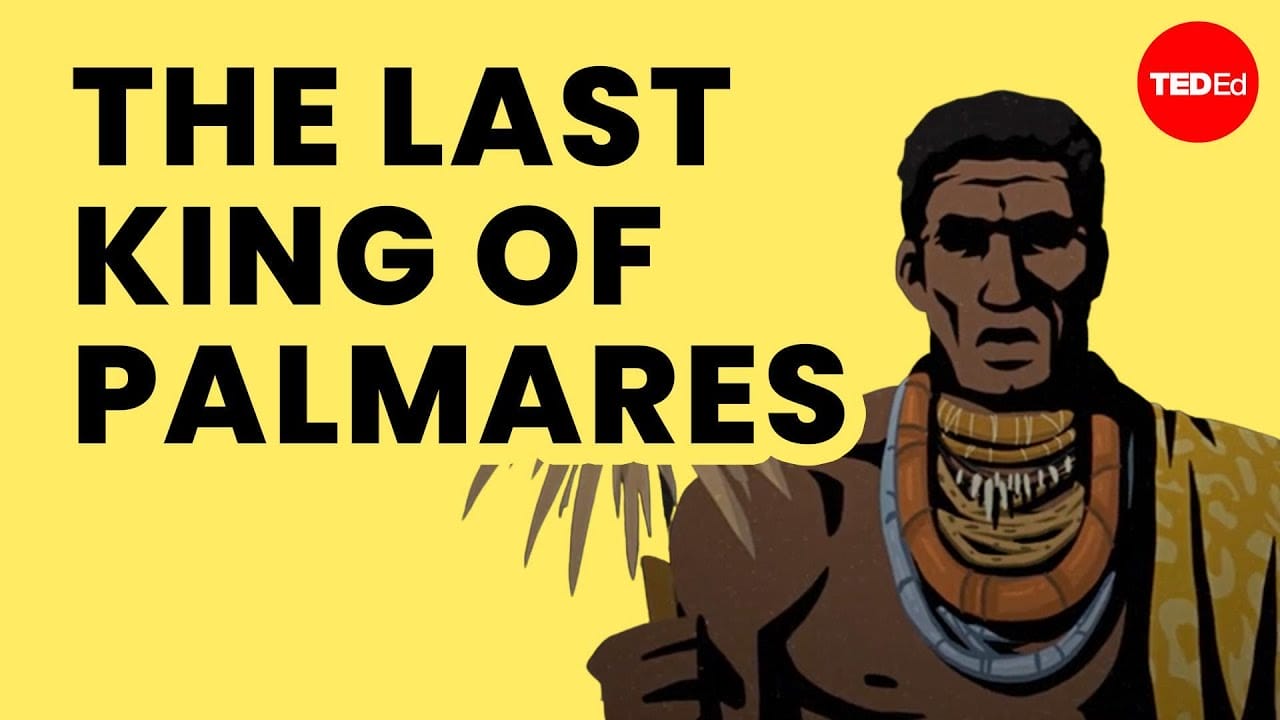
Zumbi – The Last King Of Palmares

Zoroastrianism | World History

Zoo Song Animal Cartoon & Kindergarten Nursery Rhyme by Loco Nuts

Zoe Saldana – Transportation

Zimbabwe – Geography & Provinces | Countries Of The World

Zika Virus | Educational Videos For Kids
View all video lessons, privacy overview.
| Cookie | Duration | Description |
|---|---|---|
| cookielawinfo-checkbox-analytics | 11 months | This cookie is set by GDPR Cookie Consent plugin. The cookie is used to store the user consent for the cookies in the category "Analytics". |
| cookielawinfo-checkbox-functional | 11 months | The cookie is set by GDPR cookie consent to record the user consent for the cookies in the category "Functional". |
| cookielawinfo-checkbox-necessary | 11 months | This cookie is set by GDPR Cookie Consent plugin. The cookies is used to store the user consent for the cookies in the category "Necessary". |
| cookielawinfo-checkbox-others | 11 months | This cookie is set by GDPR Cookie Consent plugin. The cookie is used to store the user consent for the cookies in the category "Other. |
| cookielawinfo-checkbox-performance | 11 months | This cookie is set by GDPR Cookie Consent plugin. The cookie is used to store the user consent for the cookies in the category "Performance". |
| viewed_cookie_policy | 11 months | The cookie is set by the GDPR Cookie Consent plugin and is used to store whether or not user has consented to the use of cookies. It does not store any personal data. |
- Learn the Alphabet
- Children's Music
- Video Lessons
AI CONVERSATIONS
- AI Homework & Project Helper
- Interview a Historical Figure
- AI Conversation Practice
- AI Book Chat
- AI Country Guide
AI TOOLS FOR STUDENTS
- AI Dictionary
- AI Thesaurus
- AI Sentence Generator
- AI Grammar Correction
- AI Paraphraser
- AI Summarizer
- AI Lyrics Generator
- AI Poem Generator
- AI Ancient Text Translator
- AI Children's Story Generator
- Role-Play Game: Fantasy Quest
- AI Figure of Speech Generators
AI TOOLS FOR TEACHERS
- AI Rubric Generator
- AI Essay Grader
- AI Prompt Optimizer
- AI Lesson Creator
- AI Lesson Plan Creator
- AI Multiple-Choice Quiz Creator
- AI True-False Quiz Creator
- AI Fill-in-the-Blanks Quiz Creator
- AI Book Quiz Creator
- AI Report Card Comments
- AI Comments for English Teachers
- IEP Generator
- AI Homework Helper

Metaphoric Poems
Ai generator.

Examples of Metaphors in Poems
A metaphor is a figure of speech that makes a comparison between two things that are usually unlike each other, and it replaces the word for one object with that of another. Unlike a simile which is another figure of speech that utilizes “like” or “as”, a metaphor makes the comparison without the use of these two words. You can usually find metaphors in many literary works and even in the lyrics of songs. So it is not that uncommon for you to also encounter metaphors within the world of poetry every now and then.
Examples of Famous Metaphors in Poetry
When reading a poem, they would often have very complex themes that would show to their readers just what kind of views they wish to impart onto the public so that they may see what they have already felt and witnessed. So here are a few examples of metaphors that can be found in some famous poetic lines:
Hope is the thing with feathers That perches in the soul, And sings the tune–without the words, And never stops at all,
And sweetest in the gale is heard; And sore must be the storm That could abash the little bird That kept so many warm.
“I’ve heard it in the chillest land, And on the strangest sea; Yet, never, in extremity, It asked a crumb of me.”
by Emily Dickinson

I’m a riddle in nine syllables, An elephant, a ponderous house, A melon strolling on two tendrils. O red fruit, ivory, fine timbers! This loaf’s big with its yeasty rising. Money’s new-minted in this fat purse. I’m a means, a stage, a cow in calf. I’ve eaten a bag of green apples, Boarded the train there’s no getting off.
by Sylvia Plath
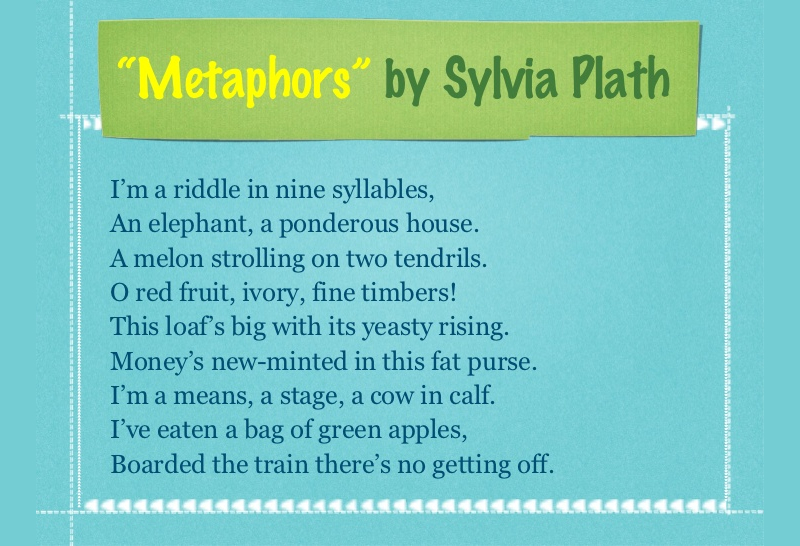
Mother to Son
Well, son, I’ll tell you: Life for me ain’t been no crystal stair. It’s had tacks in it, And splinters, And boards torn up, And places with no carpet on the floors Bare. But all the time I’se been a-climbin’ on, And reachin’ landin’s, And turnin’ corners, And sometimes goin’ in the dark Where there ain’t been no light. So, boy, don’t you turn back. Don’t you set down on the steps. ‘Cause you finds it’s kinder hard. Don’t you fall nowâ” For I’se still goin’, honey, I’se still climbin’, And life for me ain’t been no crystal stair.
by Langston Hughes.
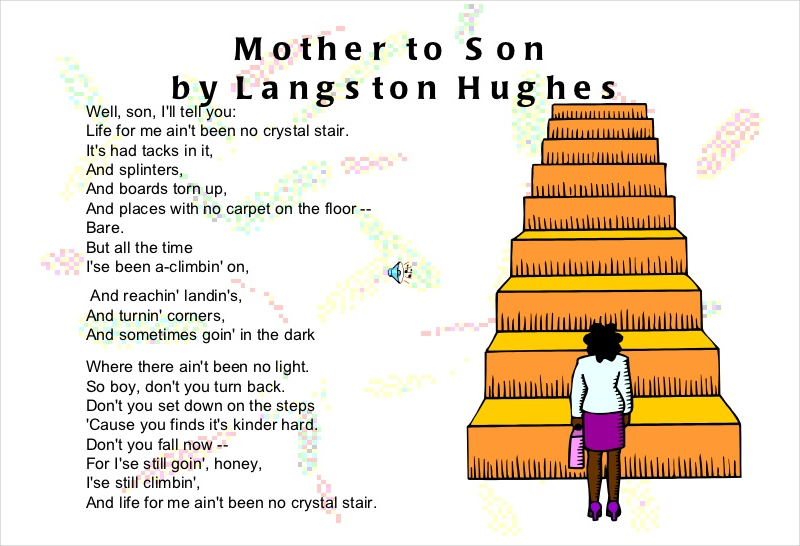
Sonnet XVIII
Shall I compare thee to a summer’s day? Thou art more lovely and more temperate: Rough winds do shake the darling buds of May, And summer’s lease hath all too short a date: Sometime too hot the eye of heaven shines, And often is his gold complexion dimm’d; And every fair from fair sometime declines, By chance, or nature’s changing course, untrimm’d; But thy eternal summer shall not fade Nor lose possession of that fair thou ow’st; Nor shall Death brag thou wander’st in his shade, When in eternal lines to time thou grow’st; So long as men can breathe or eyes can see, So long lives this, and this gives life to thee.
by William Shakespeare
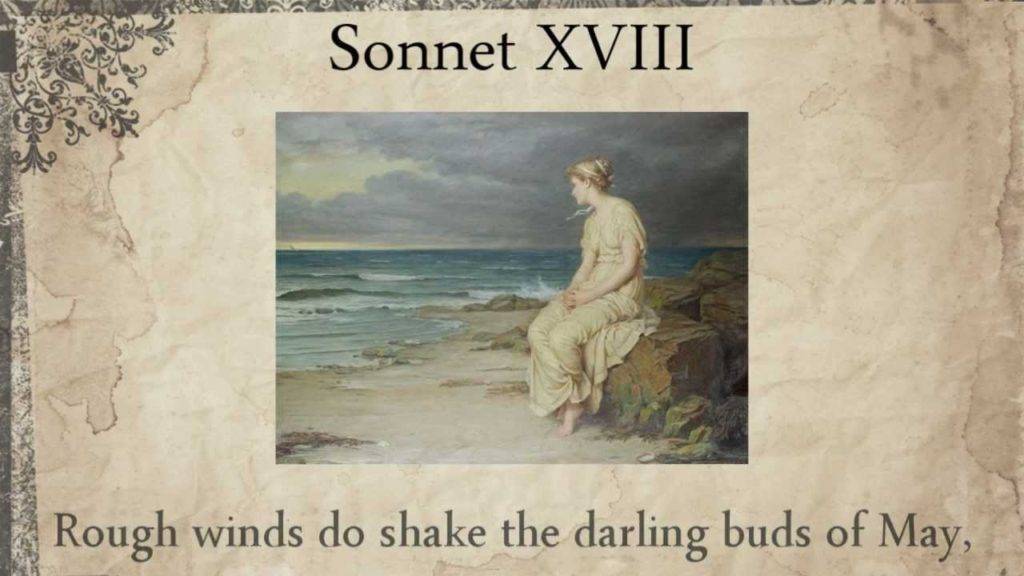
Examples of Metaphors in Simple Poems
You do not need to be a literary genius in order to be able to write poems that are filled with metaphors, there are simple ones for you to do as well. Let us show you some examples of poems filled with metaphors that are aimed at children such as:
Childhood Home
Morning is love, when mom bids me arise, Eggs shaped like hearts, a breakfast surprise. The sun barely risen, looks down with a smile, And says, “take your time, just sit for a while.” Tea time is rest, as the light starts to fade. Homework is done and the table is laid. The kettle whistles “You know me, you do.” The saucepan bubbles, “And I know you, too.” Though distance and time have claimed it from me, This home lives within, a memory. My room is a picture which stays in my head – The books in the corner, the cat on the bed. Home is my best friend, my partner, my all, Be it ever so humble, be it ever so small.

I thought it rather strange today, When visiting the zoo, To find the creatures living there, Are just like me and you. So wild and acrobatic, The monkeys in their cage, Delight in swinging high and low, Performers on a stage. Dignified and tall, the penguins on the ice, Waiters in their black and white, Proper and precise. Gazelles turn together, A troupe of graceful, dancing girls, Synchronized and slender, Performing plies, jumps, and twirls. Poor zebras are the prisoners, Condemned for life, you know, Their classic uniform of stripes, Truly marks them so. If I had all day, I’d surely make, Some other metaphors, For sloths, and tigers, elephants, And even dinosaurs.
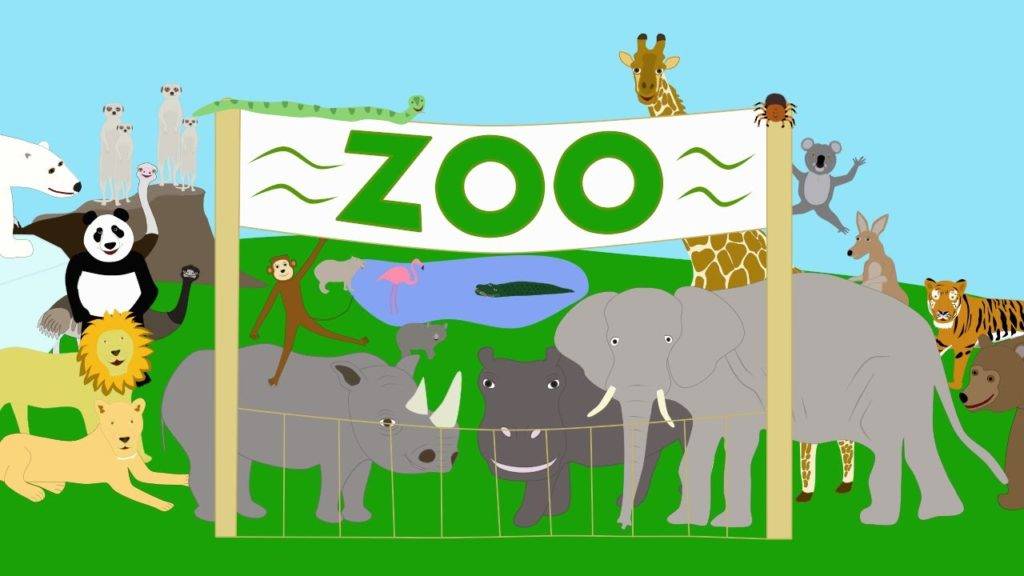
The Warrior
Each night he walks his kingdom and nods to all he meets, His confident strut, his head held high; he roams through starlit streets. He growls a swift hello, his eyes all aglow, With warrior fire, and burning desire, To be proud Scottish Chieftain. Each night he dreams in 3-D, of dangerous battles galore, Shining swords, flashing daggers, moated castles, and more. His tartan wrapped tight; he enters the fight, He leaps at his foe, but then they laugh low, He is a Chihuahua you see.

Text prompt
- Instructive
- Professional
10 Examples of Public speaking
20 Examples of Gas lighting

IMAGES
VIDEO
COMMENTS
Metaphors can make prose more muscular or imagery more vivid: 1. "Exhaustion is a thin blanket tattered with bullet holes." ―If Then, Matthew De Abaitua. 2. "But it is just two lovers, holding hands and in a hurry to reach their car, their locked hands a starfish leaping through the dark." ―Rabbit, Run, John Updike. 3.
The Big List of 125 Metaphor Examples and Tips for Writers
The term metaphor meant in Greek "carry something across" or "transfer," which suggests many of the more elaborate definitions below: Metaphor Table. Definition. Origin. A comparison between two things, based on resemblance or similarity, without using "like" or "as". most dictionaries and textbooks.
Here are 41 more examples of metaphors from content marketing, English literature, great poems, speeches, movies, television shows, songs, and more: Metaphor Examples from Content Marketing. As a content marketer, you fight a constant battle for attention. You need your words to leap off the page and galvanize your readers into action.
Instead, get creative and come up with your own unique simile and metaphor examples. Understanding Metaphors. Metaphors, like similes, are a form of figurative language that can enrich your writing by creating strong imagery and conveying emotions. However, they differ from similes in one key aspect—metaphors don't use "like" or "as" for ...
The following sections also discuss a number of studies exploring good metaphors to use in creative writing, the use of metaphors in various situations and environments outside literature, and metaphor essay examples. ... These metaphor examples for kids can involve animals (e.g. "The classroom is a zoo," "The ballerina was a swan, moving ...
A metaphor is a figure of speech that describes something (an object or an action) in a way that isn't literally true, but uses comparison or symbolism to describe something. Metaphors are a great way to add more color to your writing! Metaphors show up all over the place, especially in poetry and literature. They help writing come alive and can enhance your work by creating vivid imagery.
It also utilizes two different comparisons in one metaphor, by comparing "words" to "crumbs" and "mind" to "feast". This usage makes the metaphor much more powerful and evocative to the reader. The next example comes from Sylvia Plath's Metaphors. Here, the sentence simply reads; "I've eaten a bag of green apples.".
The term metaphor meant in Greek "carry something across" or "transfer," which suggests many of the more elaborate definitions below: Metaphor Table. Definition. Origin. A comparison between two things, based on resemblance or similarity, without using "like" or "as". most dictionaries and textbooks. The act of giving a thing a ...
Consider the following examples of metaphors in the English language that describe everyday life: 1. A blanket of snow: This common phrase compares a layer of snow to a soft, fluffy blanket. 2. Beating a dead horse: This phrase likens a redundant action to the unnecessary wounding of a dead animal. 3.
Examples of Metaphors in Literature
Here are some classic metaphor examples to get you thinking about how to use this figure of speech in your writing. 1. As You Like It by William Shakespeare. As You Like It, one of the famous plays by William Shakespeare, uses the metaphor of the world being a stage and all of the people on it are the actors.
200 Short and Sweet Metaphor Examples
Metaphors are very effective in evoking greater imagery in your writing. It could be a bit tricky to write at first though. Here are some famous metaphor examples that will inspire you to write ...
Similes Metaphors to Use in Creative Writing. We all use similes and metaphors every single day. They help us explain how we feel, make a point and add some color to our language. ... Similes and metaphors are examples of figurative language. You'll find them everywhere you look, in poetry, prose, fiction, non-fiction and song lyrics. They add ...
11. Visual Metaphor. The elephant in the room is a popular and overused visual type of visual metaphor. Visual metaphors rely on a strong visual image and sometimes puns, for example, "The elephant in the room". The picture or video communicates clearly to the reader, often without the written word.
Metaphors are commonplace in almost every kind of creative writing, but will often take center stage in shorter works like poetry and songs. At the slightest mention, they invite the listener to bring their emotional or cultural experience to the piece, allowing the writer to express more with fewer words while also giving it a deeper meaning.
An example of one of the more expressive metaphors in literature comes from American fiction writer F. Scott Fitzgerald, who once wrote, "All good writing is swimming underwater and holding your breath." A complex metaphor like this works because it is sensory. Most people know what it feels like to swim underwater while they hold their breath ...
When to Use Metaphor. Strictly speaking, metaphors should be used only in creative writing since they rely on figurative language (not literal meaning) and are therefore untrue statements. Metaphors are also often vague and may sound too colloquial for formal work. Sometimes a subtle metaphor will slip into formal work (especially in the form ...
Examples of Metaphors in Literature. Metaphors are commonly used in literature to create vivid and memorable images. Here are some examples: "All the world's a stage, and all the men and women merely players.". - William Shakespeare, As You Like It. "Her voice was music to his ears." - unknown. "The sun is a golden coin in the ...
To hit the sack: to go to bed. To be on the ball: another baseball metaphor. This one means to be alert and reactive to a given situation. To feel under the weather: to feel sick. Speak of the devil: what someone says when a person who was the subject of conversation joins the conversation circle.
From poems to plays to short stories, here are some of the best examples of extended metaphors from classic and modern literature and music. 1. "Hope is the Thing with Feathers" by Emily Dickinson. Emily Dickinson. In this poem, Dickinson compares hope to a little bird.
How To Use Metaphors in Brainstorming. 1. State the problem facing you right now. If working in a group, sometimes it's helpful to give a short analysis or describe the problem more richly. At the same time, you might work with the brainstorm participants to purge, that is: strip down and clarify the overall problem into a simple, single ...
Understanding Metaphors: A Creative Comparison. ... Knowing the difference between metaphors and similes can make your writing and speaking more interesting and expressive. The Importance of Metaphors. ... Draw a picture that represents the metaphor. For example, if you choose "The snow was a white blanket on the ground," draw a scene with ...
Hope. Hope is the thing with feathers That perches in the soul, And sings the tune-without the words, And never stops at all,. And sweetest in the gale is heard; And sore must be the storm That could abash the little bird That kept so many warm. "I've heard it in the chillest land, And on the strangest sea; Yet, never, in extremity, It asked a crumb of me."